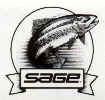|
Feb. 15, 2012:
We just got
back from our annual vacation and I'm looking forward to getting back on the
water. Tomorrow is my first day of three booked this week. I will get back
to how the fishing is. My friends say there have been some sailfish around,
the kingfish are biting, amberjacks are showing up, and snappers on the reef
are biting. So there is plenty to do, what my clients want to do I'll find
out tomorrow. Then we have a couple days flats fishing.
December 6, 2011:
MASSIVE BOAT PROJECT:
Oh my gosh, the time does fly. Just finished 5+ weeks of work
on the 23' Sea Craft. The last day of the summer season the fuel tank started to
leak due to pitting. It took me one week just to get the tank out of the
boat. First I had to remove t-top, console, and hatches just to get at the
tank. The console was tricky. I did it in a way not to remove whole wire
harness, so it had to be propped to one side and with enough room for the
tank to be pulled out. By not removing whole wire harness saved me 2 or 3
days overall, but that took the better part of one day to figure out. It
barely gave me enough room to slide the tank out after cutting the foam down
the sides and popping it free with a jack and chains to the fuel gauge port
with a 4x4 above with jack on it. I literally had to jack it up and jack it
out sideways (aft) due to the great resistance by the foam down the sides.
This was very tricky.
It took three weeks to get the tank in, shimmed and screwed
down, console down, t-top down (and weld repairs), and all the rigging back.
There were a number of other repairs or work I accomplished while the tank
and console were up which added a lot of extra time to the project. It was
not just replacing the tank. I'm glad I did it but it was a definite bitch
of a job, especially at 49 years old. The last 3 weeks were 12 to 18 hours a
day, just to get the boat in the water for my charter on 11/28. I finished
the night before at 9:30 pm, washing the boat. Three nights I worked as late
as 2 am, 1 am, and 12:30 am. And that was all starting at around 6:30 am -
7:30 am. I'd like to figure how many months of work I have on both the boats
I fish. Initially the 23'er took 5 1/2 months, 7 days a week, 10 to 12 hours
a day, and numerous days working after 12 am to get it in the water 11 years
ago This is the glamorous life of a charter captain, every year we have
maintenance during the off-season. Some years are worse than others. It was
really miserable not being able to go out fun fishing for 2.5 months, which
is the only time I get to go with my wife and friends.
BACK COUNTRY FISHING:
I still had some charters back in the Everglades and the
fishing was pretty darn good. Scott Long and his 10 year old son caught some
great fish in 3 days. Last day Scott caught a 130 pound tarpon. We also
caught numerous snook 8 - 10 lbs., and large slot sized redfish. The boy
wanted to catch a shark, so after catching snook and redfish during the day,
right before we left I sliced up a ladyfish and within 5 min we hooked up
and caught a 100 lb. bull shark.
I had another group of guys that came down for 3 days of back
county fishing. They too caught 8 - 10 lb. snook, large slot size redfish,
and nice sea trout back in the Everglades National Park. We also fished the
bridges one day when the wind was too strong for the long run back to the
Everglades. They hooked a few nice small tarpon, and caught a few nice
mangrove snapper up to 3 lb. These guys ate their fresh fish every night,
which they said was a great added bonus to their trip. I cannot remember
their names right now, but when I upload the photos I will put in their
names.
There were other trips this fall where we caught small tarpon
in the creeks, redfish in the channels, and some snook. Of course we catch
plenty of sea trout, ladyfish and jacks too when you really want to bend a
rod. Sharks are always plentiful too. It's all in the typical day of back
country fishing during the fall in the Everglades National Park.
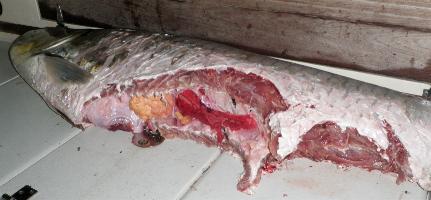 |
|
Gruesome shark attack on 135 lb.
tarpon |
August 14th, 2011:
Damn it, I wish I had the
time to do these reports with photos every month. If you could only
understand the work it requires just to keep the boats and equipment running
5 to 6 days a week. Or how about 8 full day trips in a 6 day period. That's
right, two of the days I fished from 7:30 am to 3:30 pm, then second trip
from 4 pm to 12 am. That means I got up at 5:30 am and to bed around 3
am, twice in one week, and fishing full days all the other days. You got to
love it, but it's not getting any easier at 49 years old. I still haven't
figured it out, if it's keeping me young or making me older.
TARPON FISHING:
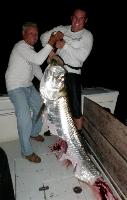
Tarpon fishing was great
once again this year. Had some great nights out there. This was the first
year we did not catch a tarpon in the 180 pound class. We caught a few
around 150 lbs., but if they are very tired or a shark is in the area I do
not measure them to confirm my estimates. We get pictures though of all the
tarpon if the clients want to, and that is more important than the
measurement unless the measurement is more important to the client.
The tarpon are still
around, all the way through the fall. Catching a big one just is not as
likely, until the fall mullet run happens in late Sept to early Oct. By a
big one I mean a tarpon of 70 to 150 lbs. The smaller ones are 20 to 40 lbs.
which are a lot of fun on lighter tackle. Just a week and half ago Gale
Porter (Jr., Jr.) caught a 65 pound tarpon on #20 test around the
bridge pilings, that was fun.
On the hook-up it jumped
wildly running down the bridge a hundred feet or so before turning to go
through the bridge. Normal this is not a problem, but we were fishing 3
lines for 3 teenagers to keep all interested. One line got on top of the
line of the tarpon, so I had to clear it instead of starting the motor and
throwing the anchor line float into the water first. So there was a nerve
racking delay, and I had to punch the boat to chase the tarpon before that
light #20 test would hit the pilings. Thank God we made it through after
this tarpon. Once we got through, he did all the great classic tarpon moves:
powerful runs, jumps in the sunset, and dogging it under the boat.
We usually use #30 test
just to give us that extra chaff protection if the line gets into the
pilings, so this was a significant tarpon to catch around the bridge.
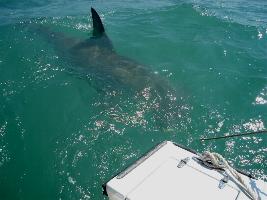

If I ever get the chance,
I love shark wrestling. Just tie a big bait on the end of a boat line and
hang on. These big 500 - 700 lb. hammerhead sharks come right up to the
boat. They thrash it, soaking everyone. Like my long time client John
Wiedemann says: "It's better than the Chicago Aquarium!"
OFFSHORE FISHING:
The dolphin fishing has
been consistent like always, but this year the big 20 to 30 lb. "slammer"
dolphin did not show up in any consistent numbers. But you could always fill
the box with fish. There were lots of "gaffer" and "heavy lifter" size
dolphin, and the larger blackfin tuna were consistent along with triple tail
and wahoo.

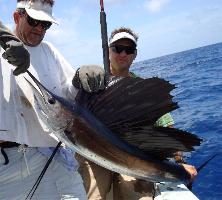
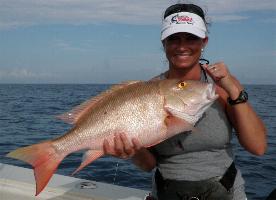
Chris and Hope
Dorsey came back, but this time instead of trying to best their 10
tarpon released one July 14th they wanted to go offshore to fill the cooler.
As we ran out we found a floating pallet, and we caught a couple nice
gaffers on it. There were a couple nice triple tail, but we could not keep
our baits from the jacks and trigger fish. We gave it a good try, but I knew
Chris wanted to catch bigger fish too not just good eating fish so we
started trolling again. We caught enough dolphin for the box, but it was
slow for the fleet on the radio - lots of undersized fish - same for us. I
started my way back in after getting over 20 miles offshore
Trolling a weed line the
left rigger gets knocked down, I turn expecting a dolphin and a billfish
comes out of water shaking and jumping all over. I could not see it's
dorsal, just it's belly as it charged the boat. I punched the boat to keep
the line tight. Then it made a nice run. Chris had the rod, and I got him up
to the bow so we could follow it. It was not more than 50 pounds. It could
be a white marlin or even a small blue this time of year, the suspense was
gnawing at me. Then it jumped up again, tail-walking right at the boat 150
yards out. I had to floor it in reverse to help keep the line tight. What
was it I couldn't see clearly, a white marlin? Then it jumped again now just
50 yards out and I see the sail, sailfish, a great fish to catch while
dolphin fishing.
 I decide to run in to hit a
wreck for snapper or amberjacks, because the dolphin fishing was spotty for
keepers. That was a good decision. First drop Chris hooks and catches a nice
mutton snapper around 14 pounds. Then we dropped a second time
for Hope, and she catches another mutton snapper around 12 lbs.
In two drops we catch two big mutton snapper at the end of the day. Now a
day that started out tough for dolphin just became a GREAT DAY: one
sailfish released, two big mutton snappers, and a good box of dolphin.
Photos will be up this week. I decide to run in to hit a
wreck for snapper or amberjacks, because the dolphin fishing was spotty for
keepers. That was a good decision. First drop Chris hooks and catches a nice
mutton snapper around 14 pounds. Then we dropped a second time
for Hope, and she catches another mutton snapper around 12 lbs.
In two drops we catch two big mutton snapper at the end of the day. Now a
day that started out tough for dolphin just became a GREAT DAY: one
sailfish released, two big mutton snappers, and a good box of dolphin.
Photos will be up this week.
It could not happen to a
better couple. Chris serves on the front lines in the "War on
Terror" in the "Special Forces" for around the last 10 years. Thank you
so much Chris and Hope for your all's sacrifice for "our safety and freedom"
keeping our enemies at bay a long way away from our country. I am so happy
you all had another great day fishing down here with me. You all really
deserve it, and you all are a pleasure to fish with.
By the way Chris bragged
about Hope's oven fried fish, which she told me how to do. It's great! I'm
back to enjoying fried fish because it uses so much less oil. And the clean
up is so much easier too.
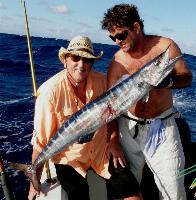
Gino Alessio, Mike, and
another friend got out for a day of dolphin fishing. We found the
dolphin and filled the box with enough of them, then decided to go out to
try for black fin tuna. The black fin were not biting that week which I told
him, but you never know when they can show back upon the local humps. It was
blowing around 20 knots that day but there was very little current so it was
not rough in 500' but as we ran offshore we got into the current. The 409
hump looked like a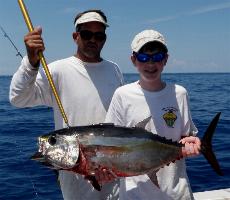 miniature "Most Deadly Catch" scene, the waves were steep
6 - 8 foot with the crests blowing over and crashing down the face of the
waves. I slowed the trolling speed down, and searched with the depth sounder
for any tuna under the surface. On one of the passes we had a rigger get hit
and as I turned around I saw another strike but it was long and skinny not a
tuna. Then we another crash on the marlin lure, and I saw a 25 pound
wahoo thrashing wildly on the #50. I backed the drag off, and let the
wahoo run. Mike was closest, so I handed him the rod. It was not easy for
Mike, that heavy rod and tossing seas. But he got it up to the side of the
boat and I gaffed it. miniature "Most Deadly Catch" scene, the waves were steep
6 - 8 foot with the crests blowing over and crashing down the face of the
waves. I slowed the trolling speed down, and searched with the depth sounder
for any tuna under the surface. On one of the passes we had a rigger get hit
and as I turned around I saw another strike but it was long and skinny not a
tuna. Then we another crash on the marlin lure, and I saw a 25 pound
wahoo thrashing wildly on the #50. I backed the drag off, and let the
wahoo run. Mike was closest, so I handed him the rod. It was not easy for
Mike, that heavy rod and tossing seas. But he got it up to the side of the
boat and I gaffed it.
The big blackfin tunas have
been biting quite well all year too. Blackfin tunas in the 20 to 25 pound
range too. When you chum them up with pilchards, and get them exploding and
jumping out of the water all around the boat - talk about exciting! Catch a
few of these on # 20 or #30 test and they will test your metal.
We catch nice sharks
offshore while fishing for amberjacks and tuna on the wrecks and humps. That
sandbar shark is about 300 lbs. Permit over the wrecks can almost always be
consistent action.
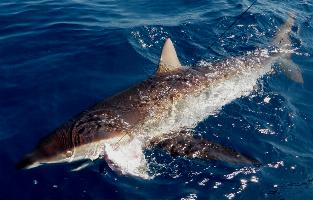
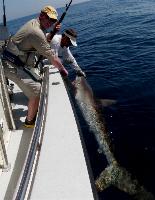

SPEAR FISHING TRIPS:
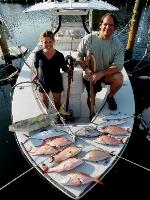 
We've had some good trips
this year. Tony Morrelo came down with his girl friend and had a good
couple dives. They shot hogfish, muttons and a nice yellow jack. I caught a
couple cero mackerel to add to their fish cooler while I followed their buoy
while they made the drift dives. That is the best way to spear fish and very
few people do it because not many people will follow the spear fishermen in
the water with the boat.
We catch a few fish on hook
and line too while we are spear fishing. Like between dives I'll anchor up
and put out a chum bag for ballyhoo or other bait. Then we'll use that for
cero mackerel, yellowtail or mutton snapper, grouper, dolphin, and nice
kingfish like the one I caught while we were eating lunch when a friend and
I went out diving one day.
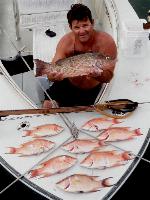
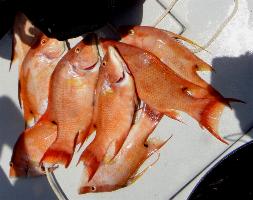 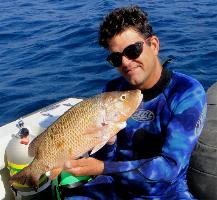
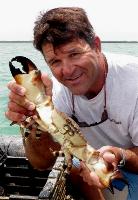
Getting ready for stone crab season. Talk about the best,
cooking your own. I got my own simple boil that is awesome, better than any
fish house - period!
April 19th, 2011:
Oh my gosh, I got to keep
on these reports. The fishing has been great! I wish I had the time to write
about it all every day or every week.
I have not even had time to
keep up on everything else to run this business: I have 4 cast nets to
repair (today I'll do 2), drags to smooth up (2 FinNor Lights and 1 Penn 50
TW), finish re-greasing last new Penn Slammer, change oils in 250 four
stroke today, fix bait pens, catch more bait, make 3 more bait pens, fix
freezer tops, rebuild spare rods, research and buy couple jigging rods and
reels and rig with braid, rig up 50 Tiagra for day time swordfishing with
electric drill and handle chuck with 110 converter to retrieve bait and lead
from 2000' deep if no bite, fishing rigs... - that's it, I cannot list
anymore or I'll get frustrated. Like friend says, "Quit Yer Bitchin'," or I
got to keep living up to my boat's name, "Crank It Up!"
TARPON FISHING:
Tarpon are here, and have
been here. Last week we caught 12 tarpon in three days of fishing, out of
having 20 hooked up and on. Joe Conroy and his friend caught 10 out of 14 on
in two of the days - that is good catching, above the average. On half day
trips we've been catching a couple tarpon for a few or more on. The tarpon
have been that average size of 70 - 130 pounds. No monsters yet, which is
unusual for March and early April.
From today on, I'm looking
at almost 100% tarpon fishing booked, along with a few offshore days mixed
in. I still have a few days and half days open, so do not hesitate to call.
For the past month and a
half, I've been doing a variety of fishing due to what the client wants to
do from offshore fishing to flats fishing.
OFFSHORE FISHING:
The offshore fishing has
been pretty good. The big black fin tuna fishing has been very good. We have
caught tuna up to 25 lbs. which is a great fight on #20 test. Some of my
friends have caught tunas up to 30 lbs. These tunas are on the local humps,
so you can always drop down for a big amberjack. While tuna fishing, you
should always be ready for a big dolphin or a sailfish to come up in your
live bait chum. The dolphin are showing up too. Mostly small ones, but
within the last two weeks the 20 to 30 lbs. slammers are coming in.
The vermillion snapper and
lane snapper have been biting, and are a blast on light tackle. They make
for great table fair, and all the local restaurants will cook your catch.
The mutton snappers have been biting on the wrecks, and before that up on
the reefs too. We caught a nice 5 pound mutton inshore on a patch reef one
day while we were fishing for barracudas to go shark fishing. The cero
mackerel have been biting well too, while we have been fishing for sailfish.
Unfortunately the sailfish fishing has been very slow for our area, and that
is why most of the guys have been fishing for black fin tuna, dolphin, and
amberjacks offshore.
FLATS FISHING:
The permit fishing has been
excellent. One day we saw over 1000 permit, and we finally caught one.
Mostly because it was flat calm which is the toughest conditions to cast
crabs at them. I also took a few casts with the fly rod, and I actually got
a nip from one. I stripped too soon, not allowing it enough time to get the
fly in its mouth. Damn, I have not cast a fly at a permit in maybe 5 years,
so I was rusty.
We have found some tailing
bonefish, close to home, but have not connected. The tarpon are now
migrating into the Keys. One afternoon after permit fishing in the morning,
we probably cast at 300 - 400 tarpon and had one make a swing and miss at
our crab we were casting. Sight casting is what the clients wanted to do.
The snook have been good
around the bridges and the back country. While tarpon fishing one day with
Paul English's son had wanted to catch a snook, so we went to one of my
spots close by and caught a nice 30" snook. They missed a few other. Then we
went shark fishing. Paul's son once again had wanted to catch a big shark.
We had a couple big spinner sharks on up to +100 lbs. which made blistering
runs and spinning jumps only to break the leader. They caught a 85 lbs.
spinner shark, and a couple smaller ones. Then we saw a big, black, bull
shark lurking in the back of the chum line. We sent out a bait, had to pull
it away from a couple big nurse sharks then finally the bull shark eat it.
We were off to the races. What a great shark. It took about a 200 yard run
by the time I got off the anchor. By the time we got up to it, it was 500
yards from where we hooked it. A 40 minute fight ensued until it was subdued
next to the boat for nice pictures. I think it was around a 250 pound bull
shark. I got to call Paul to get the photos.
Feb. 22nd, 2011:
Wow, it's been 3 months
from my last report and it's good to be back and fishing. Once again I
return from an epic surf trip in Costa Rica of 2 months, the only break we
get a year. A lot of my friends steam with envy I take 2 months off, but I
dream of weekends off, national three day weekend holidays, and two or three paid
vacations a year during the 10 month blitz we trudge through working 7 days
a week. That's right, we work 7 days a week the rest of the year. I'll try
to write a little about my surf trip at a later date.
TARPON FISHING:
Tarpon fishing is just
starting. They have already arrived according to one of my dear friends who
guts it out every winter, instead of going down to visit me in CR to surf,
spear fish, and drink while camping out on the beach with "old Capt.
Killgore" (we had a great trip a few year ago, and he almost made it down
this year but couldn't - so I called him a few time to twist his arm!). He
told me the first few tarpon arrived the week before I returned on the first
good warm spell of the winter. That is what usually happens in mid - Feb. So
as the water gets over 70* F the tarpon will start biting.
OFFSHORE FISHING:
Oh my God, I thought the
amberjack we caught on Fri. was "big" which it was, until 2 days later -
sorry Pat. I did not realize the significance of this amberjack, until my good
friend who used to commercially fish amberjacks told me. He had caught
25,000 lbs. a season for 15 years (do the math). He was impressed with the
amberjack we just caught, because he had only caught 6
amberjacks over 100 lbs. My friend said I should have killed it
because so few over 100 pounds are caught.
Yesterday,
Casey McDermitt (age 15) fought this
amberjack for 45 min. on # 50 test stand-up tackle. This amberjack measured
68" to the fork and 38" girth. Before I measured it, I estimated this
amberjack to be at least 110 lbs. The "fish formula" measurement puts it at
123
pounds, but they inflate a little as they come up out of the deep. If you take off
2" from the girth (which I think is too much to reduce it by) it comes
out to 110lbs.
I think it was a 115 lbs. amberjack.
That's Casey (left-center). He is 6' 6" and is a 260 lb. lineman on his JV
football team (I feel sorry for the kids across from him). He had great patience and persistence while fighting this
amberjack, never frustrated and always impressed with each run.
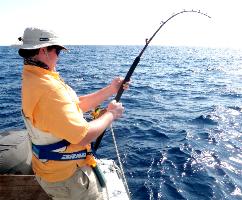

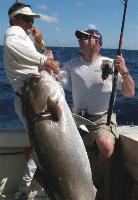
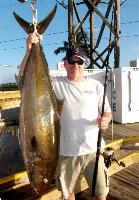
Two days earlier my first
day back on the ocean with my Sea Craft, we catch the largest amberjack ever
on my boat, until yesterday. Pat Dowling from New Jersey wrestles up
a 91 lbs. amberjack with no less than my big spinning rod with
# 80 test braid. Now we typically catch 30 to 40 lb. amber jacks on this rod
with a metal jig, and we catch the bigger 65 to 75 lb. amberjacks on live
bait and my big # 130 test stand-up rod. That's what makes this a hell of a
catch, with 15 pounds of drag for 25 minutes at least, holding on for dear
life on the brutal runs and pumping her up in between the runs with no
stand-up harness to hold the rod, that's what makes this an impressive
catch. Pat is a big boy, and loved every minute of it.
It is one of the toughest
fights in the ocean around here, not just because they are 75 - 115 pound
jacks (if you've ever caught a small jack, just imagine it). But it is a
sprint of a fight. You can not let up for one second and rest, because
you're trying to get the fish to the boat before a +900 pound tiger shark
eats it up to its head or just swallows a 40 lb. amberjack whole and cuts
the mono leader. How do I know there are some +900 pound tiger sharks out
there, my commercial fishing buddy caught one one day after he could not get an
amberjack
into the boat.
When we go for the big
boys, I strap the angler in to a kidney harness and a big stand-up fighting
belt which holds the # 130 boat rod so we can get these big amberjacks up as
quick as possible. But the day before Casey caught his 115 pound amberjack,
my # 130 drag slipped a couple times so since we caught that 91 pound
amberjack on that big spinner with 15 pounds of drag I decided to used my #
50 test stand up rod with 15 pound test maximum drag setting. We were lucky
we got it up before the sharks got it. Later we lost a nice tuna to a shark.
INSHORE FISHING:
Just as I got back, and was
getting ready to start installing my new autopilot on the 23' Sea Craft, I
get a call for half day flats fishing on my 17" skiff. So I realize during
the call, hey I've fished this boat for 10 years without an autopilot so I
can fish next weeks trips without it. I take the trip, and had a great
afternoon on the water three days after returning from CR. We wanted to find
some bonefish, but the water was 63* on the ocean side flats coming out of
the bay. I found an area that was 69* and there were some bonnet head sharks
and box fish around but no bonefish. We tried some chumming for bonefish in
some deep water to no avail, so I decided to do some barracuda fishing.
We headed out to a small
patch reef to cast some tube lures. Dave and his wife Cathy from Connecticut
had a great afternoon. Dave hooked a nice barracuda, that ripped the line
through the water then did a 180 and cut the tube lure off. Cathy started
whacking the fish on the bottom with a shrimp. She caught 7 keeper porgies,
a just too small mutton snapper, a number of small grouper, and small
mangrove snapper. Dave had another big barracuda charge the lure. He didn't
hook the fish, but it sure got him excited. Dave started fishing the bottom
with his wife, and started banging away at those fish his wife was - pretty
fun on #10 test.
The water is warming so all
the flats fish will be coming back to the flats now. March is a great month
for: tarpon, permit, bonefish, snook, big sharks, big barracudas, big jacks,
mangrove snapper, Spanish mackerel, big sea trout, and even cobia. What else
can you ask for? More than you can fish for in a day.
Nov. 20th, 2010:
Wow, how time flies. In the
last 2 1/2 months I did not realize it's been so long since I did an update.
We have been doing a little bit of everything: offshore and inshore. It has
been the typical fall fishing, except this year has been a real struggle for
the backcountry snook fishing. The redfish fishing has been very good
though. We have been catching tarpon around the bridges and in the
backcountry. One half day we caught 3 bonefish. Caught some big Spanish
mackerels the other day, along with some nice trout, and one spot it was
every cast for a jack. It was a great half day, because one of the guys just
wanted action for his first fishing trip.
The dolphin and tunas were
biting all fall real good. Some big ones up to 25 lbs. showed up about a
month ago. The sailfish have started to show up in the last 2 weeks, but I
have pulled my boat to do the annual work on it before a few trips around
Thanksgiving.
Sept. 4th, 2010:
Same story, different day:
I have not been able to get to my regular fish reports. Thank God, I've been
too busy. We have been doing a little bit of everything, from offshore to
the backcountry, and I cannot forget the diving too.
OFFSHORE FISHING:
I have wanted to catch a
big wahoo in Islamorada for years, say over 40 lbs is respectable; but I
never imagined we would even hook one the size we caught Aug. 16th.
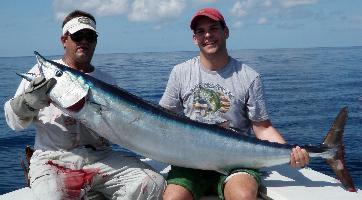 Kemp Mosley from Mississippi caught this 67 lbs. "monster
wahoo" first thing in the morning. We weighed it 7 hours later, so it
would have lost 5 - 10% weight which would have put it over 70 lbs. This is
a very large wahoo for Islamorada and even for the Florida Keys. Kemp Mosley from Mississippi caught this 67 lbs. "monster
wahoo" first thing in the morning. We weighed it 7 hours later, so it
would have lost 5 - 10% weight which would have put it over 70 lbs. This is
a very large wahoo for Islamorada and even for the Florida Keys.
When this wahoo first came
up behind the boat, I thought it was a small blue, but in a second I saw it
was a huge wahoo. I jumped into action, quickly tying on a kingfish rig for
a big live pilchard on a #30 trolling rod. He did not want that. So I had to
rig a bigger bait, which meant a new leader and bigger hook. Rigs and boxes
started flying around, but I got it done quickly and slapped a big bait out
there.
First time this big wahoo
ate it, I let him eat it a good time then reeled down and struck as hard as
I could, the bait pull - too much line stretch. I cranked it back up and he
followed it up. I fed him again, but this time I put the rod in the rod
holder and punched the boat to stretch the line to set the big hook. "Damn,"
he coughed it up again. "Stupid Killgore," I said to myself because I just
remembered I use light drags in general, and the strike was to light to set
the big bait and hook. I cranked it up again, and here comes that wahoo. I
feed him again: a good drop back, set it in the rod holder, put the drag up
to full (about 15 lbs. of drag I know), and punch the boat for 50 yards.
Hooked up, finally.
What a nice run it made and
a long fight. We played him conservatively, but I was worried about sharks.
So I had the drag up a bit, but when it would run I'd back it off again.
After a while, Kemp and his family were wondering, where is it? "Patience,"
I said. "This is a big fish and you do not want to force it. You got to go
with the drag settings." Ten minutes later we could see the wahoo down about
100 feet.
After another ten minutes
of working the wahoo up, I was not going to wait till it got to the surface
for a perfect gaff shot. Instead, I reached down as far as the 8' gaff would
go while the boat was in forward. I did the the same thing in 1988 with a
542 lbs. blue marlin down in St. Thomas, because so many things can go wrong
that last 6 - 8 feet up. That story will follow this one.
As I slowly moved it right
behind the head for a great shot, the wahoo turned and came right toward the
boat! I rushed a shot at it, got him a little, then the gaff's butt got
stuck in my t- shirt under my under arm. I couldn't keep good pressure on
it. The ladies were up my side of the gunwale taking pictures - "GET OUT OF
THE WAY!" I ran up the side of the boat, keeping pressure on the fish with
the gaff. I finally unwrapped it from my loose shirt, and worked down
towards the middle of the gaff with the wahoo at the surface. He was barely
gaffed, right through the lower jaw, up and out of the front of the mouth.
I feared, "is it enough to
lift this monster wahoo over this part of my gunwale that is 3.5 feet up?" I
was half way up the side of my boat in front of my consul. Well, I'm not
going to risk loosing it by re-gaffing it. Now the women are behind me on
the other side of the boat in front of the console - "GET OUT OF THE WAY!" I
had no time to explain myself. And as I heaved it into the boat one big
motion, I knew I had to jump out of the way of those razor sharp teeth, and
also have no one else in it's path. When the wahoo hit the deck, the hook
fell right out of its mouth! That is why you gaff a fish at the first
opportunity.
There is saying, "if a
wahoo just gets close to you on the deck, he can slice you up!" There have
been more mates and fisherman sliced up like that, and that I explained, I
was very concerned about when boating this big wahoo. The ladies and their
husbands understood.
That is the story of this
great big wahoo, which took about 40 minutes to land. Here is that 542
lbs. blue marlin story and about gaffing it deep at the first
opportunity.
Dr. Imhoff took his boat to St. Thomas
to catch a blue marlin more than 500 pounds, and this was it. We
knew it when we saw it grey hounding across the rough St. Thomas sea. I
knew this was going to be "a money shot" on the gaff, and I was not
going to wait till it got to a comfortable distance. I was going to
reach out and hit it as soon as I could. By the way, I got a $700 tip
that night on top of my $125 daily fee. That's a great pay day for 1988.
As this fish came up on
the leader, it was down deep and digging hard as the boat was in
forward. As far down as I could put the flying gaff , I held it against
the current around six feet down with the big gaff point trailing in the
current, parallel to the fish. Once I felt the back of the fish with the
bend of the gaff hook, I pivoted the gaff and went down further until
the point was making good contact. I sunk it in, but not to hard to
alarm the blue marlin. Almost like a live bait for a kite, right behind
the dorsal fin you can see the mark in the photo.
I released the pole and
I took a wrap on the flying gaff rope. The 1st mate, Steve, was on the
leader, and we started pulling the big blue marlin up simultaneously. I
had told Steve earlier, "once we gaff the blue marlin we got to grab the
bill and get at least one half hitch on it with the flying gaff rope,
preferably two if not three." When the blue marlin broke the surface, I
could see the bill was just "sitting in the bend of the hook with the
barb backed into the bill" just holding the hook there! As Steve grabbed
the bill so I could half hitch the bill with the rope, the hook fell
out! I hitched it twice, gave the rope to Steve, and I then gaffed the
blue marlin again with the second flying gaff, mid-torso. You can see
both hole marks by the gaffs in the photo.
Again, gaff every fish
on the first opportunity. If we had horsed this fish and alarmed it, or
if I had not gaffed it deep, it could have come to the surface, shook
its bill, and thrown the hook. Game over, and that 542 lbs. blue marlin
Dr. Imhoff had fished a month for would have been gone at the boat.
Dolphin and blackfin
tuna have been very good offshore. Every day we go out, not a problem
catching some nice summer tuna an some dolphin. I
got my wife out the other day for a long half day. I caught 600
pilchards, then made a scuba dive down the reef, before heading offshore to
the hump.
We got to the hump, and as
soon as we started throwing pilchards out we were hooking up two at a time.
Three we could not stop and they got eaten by something big. We caught two
ten pound tunas, one was a small yellowfin tuna. Then I rigged up my
fly rod for tuna, and when I stood up there were some nice gaffer size
dolphin around the boat. I through out a scoop of pilchards, and hooked a
nice 12 lbs. bull dolphin on my fly rod. He made some nice 6 ' jumps and
after he settled down, I gave the rod to Elena so I could hook another one
up for her. I hooked one up for her, then switch rods again. When she got
hers up to the boat for gaffing, we switched again so I could gaff the fish
and put it in the box. She gave me back the fly rod, and I brought the
dolphin to the boat for her to net it. Now she had a little trouble getting
it in the net, but she got it.
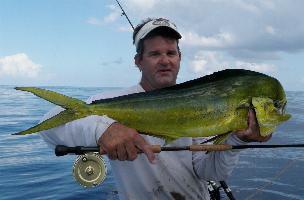
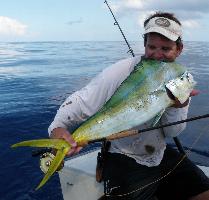
As I was putting more ice
in the fish box, Elena looks over the side of the boat and sees three 20
lbs. wahoo. I throw over another scoop of pilchards and those wahoo start
darting everywhere. By the time I get a wire rig on and a bait out they
disappeared. They did not stick around like the other wahoo. Later we caught
a couple triple tail under a huge tree and its roots. I actually got in the
water to see if there were any wahoo or dolphin hanging down deep under the
tree. I dove down a few times 30 - 40 feet, but all I saw was one 4' shark,
trigger fish, and bar jacks. Coming up to the tree and all the fish around
it and the triple tails was very cool.
INSHORE FISHING:
Tarpon fishing this
past Aug. has been better than I expected around the bridges. Typically, we
are catching smaller 30 pound tarpon, but this year every time we went out
we caught a 75 to 85 pounder and hooked another or two.

Scott Lewis from Hendersonville, NC went out for a half day trip
fly fishing for bonefish and baby tarpon. I caught a very nice 10 lbs.
tarpon on fly along the mangrove shoreline of one of the islands out in
Florida Bay. These are great fish for one of your first saltwater fish on
fly. They eat the fly readily, and jump all around the boat.
Sea trout and
mangrove snappers were biting very good back in the backcountry mangrove
creeks, which make for a fun action packed trip for those who do not want to
frustrate themselves with the challenge of sight fishing for bonefish,
permit, and tarpon. We incidentally released the biggest trout I have ever
seen. I'd say it was around 30," but my client who fishes Indian River a lot
said he'd say it was over 30" and go around 6 - 7lbs. I might go with what
he said. I saw it briefly, then turned to get the landing net out. We had
just moved and I had stowed the net. His nephew, an avid bass fisherman, had
it right at the boat and his uncle had a great look at it.
June 21st, 2010:
I'm sorry it has been two
months since I did a fishing report. Thank the Lord I've been fishing 6 days
a week, and that one day off I'm actually working harder on boats, tackle,
bait, etc. I'm not going to post any photos right now because I've detected
problems in the resolution of finished photos after resizing from my new
digital camera.
TARPON:
Tarpon fishing has been
great! We have caught as many as 6 tarpon for 9 hooked up
and 14 tarpon striking the baits one full day trip. The largest
tarpon we've caught measured 84" to the fork and 42" girth which comes out
to 186 lbs. using the "fish weight formula." That's a big tarpon.
Maybe 90" over all length, imagine that!
We have been probably
averaging 4 tarpon per full day trip. Quite a few days we've caught 5
tarpon. If we spent less time fighting tarpon, we would be catching more
tarpon per trip. Everyone want a photo with their tarpon, so we have to
fight them another 10 to 20 minutes until they are docile enough to safely
handle them around the boat for pictures.
BIG TARPON on FLY at
NIGHT: The perfect scenario for your first big
tarpon on fly!
We have even been catching
tarpon on fly at night! I may have designed a great night
tarpon fly. The first time we used it, James
Ovelman hooked 3 tarpon out of 4 strikes in 15 minutes of
fishing. The third one he hooked he fought for 1:36 hours and had the leader
in the rod tip many times for a technical release, but we never got a lip
gaff in it for a photo. This was an epic battle up and down the bridge
weaving through the pilings. He put out standing pressure on this fish, his
first big tarpon on fly, but by no means did he play it conservatively. He
has been fishing with me for years and caught big tarpon on bait and knows
the pressure we got to put on them. This tarpon was BIG, maybe 130 lbs.
and it dragged us through the bridge pilings at least 1.5 miles, then turned
back to go maybe 1/4 mile back the other way until it finally broke us off
in the pilings - Wow! This is what James has dreamed about for years, and
has fish with some of the best fly fishing guides of S. FL. He was stoked
even though we did not get it up for a photo.
The next night we bait
fished until dark catching a couple tarpon and jumping a few, then we broke
out the fly again. The tarpon were not as active as the night before, but in
40 minutes of fly fishing James hooked two tarpon and caught the
perfect size tarpon on fly, a 70 pounder. It made some great jumps and
runs, and we got it up to the boat for some nice photos which I will be
posting soon.
Sean Borgenson came down for 2 days fly fishing. The second day
we did a half day night trip, and he hooked a nice tarpon up on fly which
jumped greatly and ran deep into his backing before it broke the shock
tippet - bizarre. Sometimes leaders can get in the deep corner of the hinge
of the jaws where it can get bit off like a pair of dikes which are not
sharp.
I am very excited
about this fishing for the novice tarpon fly fisherman. This could be
one of the greatest ways to catch "big tarpon on fly" down here in the FL
Keys. Fly fishing for tarpon here in the Keys has been getting harder and
harder over the last decade due to the pressure during the day - they have
seen every fly in the book. Over the years my anglers have expressed their
frustration. It is one reason I moved into "live bait fishing," I love
catching tarpon. Now I know a couple guys that "fun fish" at night with fly
for tarpon down here, but most of their tarpon are small (under 50 lbs. and
mostly 30 lbs.). The tarpon we were hooking on my fly were all big tarpon,
70 pounds and larger. I'm looking forward to targeting this "night time
tarpon fly fishing," especially this July.
I have typically had good
night tarpon fishing in July, and even during the day sight fishing with fly
can be more productive because less fly fishermen are fishing and the tarpon
can be more hungry. There are less tarpon moving along the flats, but they
can be more aggressive to the fly.
OFFSHORE FISHING:
fishing has been good for dolphin (Mahi Mahi), black fin tuna, permit,
and billfish are around offshore.
This time of year 99.9% of
my trips are tarpon fishing. That is what my clients want to do. I get a few
trips of variety during tarpon season, but until tarpon starts to wind down
I will not start to fishing for the other fish we have here, even though I
love our diverse fishery and fishing for them.
The dolphin fishing
(Mahi Mahi) has been very good also, and we have caught some nice fish this
last April through June. One memorable catch was with
Dave Hamilton and his wife on their
honeymoon, and they caught "a double header" of big dolphin, "slammers,"
that measured 61" and 54" which was a good fire drill. With a mess of small
dolphin they took home around 80 pounds of fillets.
 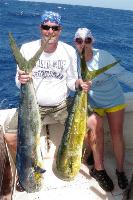
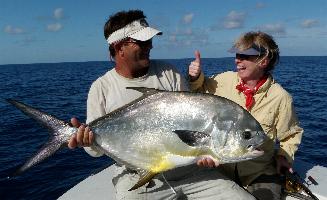
Susan Haight caught her first permit, a big, 43 pounder,
off one of the local wrecks last week. It fought with every ounce of its
body in that 100 foot water. It took every bit of 25 minutes, maybe even 30.
Most days I've been
offshore we have seen 2 billfish each day free jumping including two blue
marlin, one around 350 lbs. and another around 125 lbs. So I'm looking
forward to hooking up that illusive blue marlin every day I go offshore.
Black fin tuna and
Skipjacks have been plentiful offshore and on the humps. It is
exciting to chase the schools offshore and hook up to one of these very
powerful fish. Sometimes yellow fin tuna can mix in with them, and we're
always hoping to hook one of them. Also fishing one or two of these tunas
live is a good idea for a shot at a blue marlin or mako shark.
Black fin tuna are an excellent fish to add to the fish box, and the
skipjack is a close second in food quality. Both fish have to have the blood
line removed, just like yellow fin tuna, and any other fish before cooking
and freezing.
INSHORE FISHING:
Fishing has been good for bonefish, trout, mangrove snapper, snook,
and big sharks.
We have gone bonefish
fishing once for half day and boy did we chum up the bonefish that morning.
We lost one bonefish and probably chummed up 2 dozen fish in a 1.5 hour
period while the tide was peak. The toughest thing is to get the bait in
front of the moving bonefish. They come in and leave quick. They were coming
in as singles, doubles and even once 6 bonefish came in that morning.
The other backcountry trips
I've had, we've fished the Everglades and had some great sea trout
and snapper fishing. These were rod bending trips, and the fish were
biting. Almost every cast we were hooking a trout and up to 20" which is a
nice trout.
Just the other day we
were into the nice snapper for the Everglades which I was just flipping
into the boat; then Jesse, Brian Connolly's
nephew, cranked up a trout that I would say was 27'
- 28" and 5 plus pounds. I've honestly never seen one that big.
Brian said it was bigger, because he's caught trout that size in
Mosquito Lagoon. He said it could have been 30 inches.
When I saw it I
screamed, "keep its head in the water, don't lift it up!" I turned
and wrestled with the landing net to get it out from under my poling
platform where I store it. I finally got it, turned and it was gone!
With a shocked face, young Jesse then smiled and said, "that was the
biggest saltwater fish he'd ever caught!" He was a very good bait
caster, which he expertly fished all morning this old Ambassador bait
caster I brought to try. He is an avid bass fisherman from Orlando area,
and could cast that old reel quite well.
I've been wanting to try
bait casters to drift live bait for snook and baby tarpon so the clients do
not twist the line when they are fighting the fish. Later the twisted line
will tangle in the reel or rod tip and get chaffed up or snap. If I like it
I will add a few nice bait casters to my arsenal of tackle. I'm also
thinking about the same principle for offshore, but logically they would be
nice lever drag conventional reels.
By the way, one of my
clients fished with one of my friends for snook and had a great day.
They caught 7 - 8 snook up to 12 lbs. and lost just as many or more. So I'm
looking forward to getting out snook fishing soon.
April 14th, 2010:
Wow! I have been getting
slammed with some last minute bookings and some great fishing!
It could be a great year
for tarpon! The first tarpon we caught was spectacular! It jumped at
least 15 times, and was a big tarpon (at least 135 lbs.). It jumped
all around the boat, almost hit the boat, even after over an hour of
fighting it on #20 test.
The tarpon are about one
and a half months over due. Where they start showing up in late Feb, they
just started showing up first week of April. So it might be a later season
where we could have great tarpon fishing all the way into late July. One
year we caught 10 tarpon on July 14th, and many days that year we
released 6 - 8 tarpon all the way till last few days of July.
Fishing along the reef
has been great this past month. We have caught sailfish, big
kingfish (up to 46"), nice black fin tuna, big cero mackerel (up to
10 lbs.), groupers, nice vermillion snapper and lane snapper for fun filled
full days and half day trips.
|
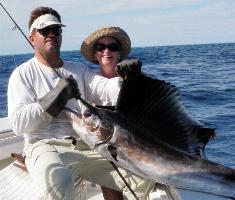
Her first day offshore fishing she catches a sailfish and
numerous king and cero mackerel. |

"Half day snapper and mackerel
fishing"
That is a mess of vermillion
snapper and lane snapper for David Nix, Kelly, and their son, Devin. |
|
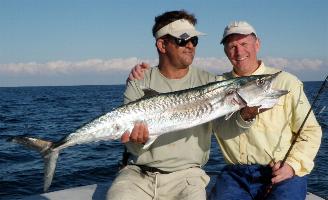
Jeff Gurski catches a nice king, and
friends caught around ten others while fishing for sailfish.
|

Steve Williams and friend catch ten
big cero mackerel up to 10 lbs. while fishing for sailfish. |
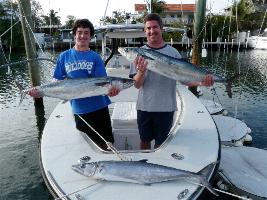 The big
kings were biting. We kept 3 of the 6 to the boat and missed twice
as many. Repeat client, Joe McKinley and his son were stoked. No
shots at sailfish that day, but the kings kept us busy. |
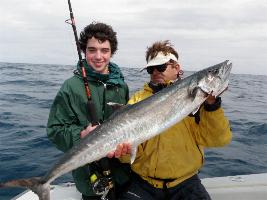
Joe McKinely's son catches a 46" kingfish while
fishing for sailfish. |
Offshore fishing has
been great too. We have caught numerous amberjack in the 60 - 70
pound range. While we are fishing for them, I like to have another
angler on the bow jigging for black fin tuna where we have caught some nice
tunas up to 15 lbs. They fight well on #30 test, and it is fun getting the
bite yourself. We have also caught nice amberjacks on these jigs too, but
they are in the 30 - 40 pound range, which is perfect for #30 test. The
dolphin have started to show up too, but I have not fished for them because
they are typically small this time of year.
|
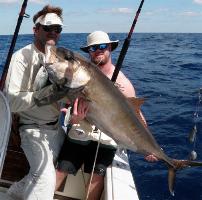
Shane McDermott says these 70 pound amberjacks
are good workouts while on spring
break from UM's spring football camp. He is
their freshman center. Best of luck buddy! |

Randy McDermott, loves jigging for those tunas on
the hump while we are fishing for amberjacks. They are a fun fight
on spin, and great little steaks for the grill too. |
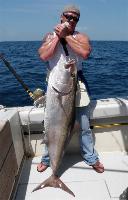 Brandon Wilson, veteran of Iraq and
Afghanistan, says these 65 lbs. amberjacks are tough!
Thank you for fighting for our freedom buddy! |

Rebecca Kravetz, sixteen year old,
came to catch offshore fish. Black fin tuna will teach you about
"persistence!" She also caught numerous other king and cero
mackerel. They were tearing us up for a while, as fast as I
could put a bait in the water. |

Tom Pennekamp takes the kids fishing. Nice
lane and vermillion snappers. They caught many more kings and snapper,
but we let them go. |
Bay fishing has been
very good too. Spanish mackerel were hot and heavy during our colder
March where we were catching them as fast as we could put a bait in the
water. Catching them on fly rod is great fun for the beginning saltwater fly
fishermen. Big ladyfish, sea trout, pompano, bluefish, jacks, and snapper
all come into the chum line for fun action on light tackle.
Big sharks on the flats
are the big game of the bay before the tarpon show up, and we were ripping
their lips (and removing other lost hooks when I find them) this past March.
We've had some great days catching more than a dozen sharks and loosing just
as many. Having numerous sharks swimming all around the boat trying to find
our baits, either live bait or cut bait. We've been catching lemon sharks up
to 200 pounds on #30 test, black tip sharks up to 100 pounds, and smaller
sharp nosed sharks up to 30 pounds on #20 test.
The flats fishing
has been very tough in March because of the cold March we've had, but it is
just going to get red hot as the weather warms. Bonefish have been slim, but
one half day charter for fly fishing I chummed up some nice 5 - 7 pound
bonefish in low 70 degree water in 1.25 hours chumming. Then the current
stopped so we went poling for bonefish, permit, baby tarpon, and small
sharks. I've also gotten reports from my friends that they have been
catching some nice snook in the back country, so hopefully they have not
been as hurt from the cold water "fish kills" of past January as some have
feared.
|
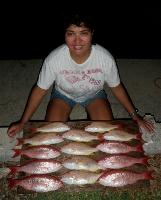
My wife, Elena, and I go out to catch a little mess of nice lane and
vermillion snapper after my half day trip in the morning. |
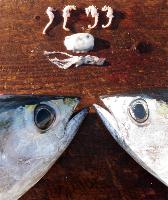
Can you believe what these black fin tunas are
eating: sea horses, squid, and a baby "Mola Mola?" |
Feb. 20th, 2010
For those of you who have
noticed, I have not posted any fishing reports for awhile. I was on my
annual vacation down in Costa Rica, which I take every year this time for a
good reason too. The weather is so adverse this time of year, we get lots of
cancellations. One of my friends was lamenting he had to cancel 75% of his
bookings which were not much anyway. He swore he is going to be visiting me
next year down in CR. Just a little dig at all my guide buddies here in the
Keys suffering the winter chill, my wife and I were down in CR surfing,
spear fishing, and drinking for weeks on end. I'll post some photos soon. I
got some cool photos of the fish I speared, mussels we got, dog we adopted,
and some good times with friends.
Boy was it good to get out
fishing, the boat under my feet, salt spray on my face, and wind in my hair.
We returned last week and within a week I was out fishing and catching fish
even in these tough, cold, windy conditions. I had a couple "Irish Blokes,"
John Gleeson and Ferdinand Heyerman, fishing two days this week
offshore and backcountry. Offshore was a little slow, but they had 2 shots
at sailfish that just could not catch our live ballyhoo. The current was
very slow and the kingfish were not cooperating. We got a couple nice bites
on the bottom rod on a wreck but failed to hook'em. We wrap it up fishing
the edge of the reef for sailfish, kingfish, and cero mackerels which they
caught a few cero mackerels.
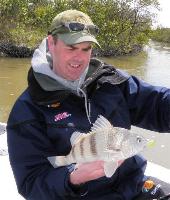 The next day we ran back to
Flamingo and East Cape to fish for black drum, and that paid off even though
the water temperature was very cold. They caught around 20 nice black drum
on #10 spin, a few nice trout, and a redfish. Hey, could we call it the
"Back country, Poor Man's, Rock Bottom, Channel SLAM!" Why not, everyone
else is creating all these other versions of "fishing slams!" The next day we ran back to
Flamingo and East Cape to fish for black drum, and that paid off even though
the water temperature was very cold. They caught around 20 nice black drum
on #10 spin, a few nice trout, and a redfish. Hey, could we call it the
"Back country, Poor Man's, Rock Bottom, Channel SLAM!" Why not, everyone
else is creating all these other versions of "fishing slams!"
Sorry, I do
not think so. FISHING GRAND SLAMS should be something very hard to accomplish,
like the original slams: tarpon, bonefish, and permit; or sailfish, blue
marlin and white marlin all caught in "one day" - not caught over a two
or three day tournament! This also has bastardized the true significance
of a "Grand Slam." It's just sad to know there are people that believe
they caught a "Grand Slam" in these tournaments. You got to feel sorry
for them, they're victims of shrewd marketing.
Anyway, these guys had a great
time back in the mangroves, and they even saw a "bald eagle" on the way out
on a stake in "Tin Can Channel."
(John Gleeson with one of
many Black Drums on light tackle)
Sept. 2009:
Sept. has been a great
month for me this year for both business and fishing offshore and
inshore. 
Offshore fishing: We
have caught dolphin, black fin tuna, sailfish, kingfish, grouper, and
triple tail.
I took out local Will
Kennedy owner of Chillie Willie's Restaurant and his two sons Cullen and Cody, 10 and 6
yrs old. They had entered the kids tournament at World Wide Sportsman, which
is a fun tourney of half a day fishing for as many kids as possible. I was
told usually barracudas and amberjacks win biggest fish, and there is an
outstanding catch award for sport fish. So I told Will I know where
there are some big barracudas out on the reef, and we could also catch a
sailfish too, because I've seen a few around since late Aug. We could not
have planned it better. While every one else headed out to the humps for
tuna and amberjacks, Cullen caught his
first sailfish winning the
outstanding catch in the offshore division. They also caught 3 big
barracudas, and one out of two kingfish all in a short half day (running
time back to dock was part of the 4 hours of fishing). Cody won 3rd place big fish with
his 23.8 lbs. barracuda on #20 test, which put up a great fight. Will got
the whole sailfish battle on video, because Cody was bringing to gaff a
kingfish when the sailfish ate one of the rigger baits that was out. I still
had three live ballyhoo out while we were catching the kingfish, I cannot
tell you how many sailfish we have caught while fighting another fish like a
kingfish or a grouper.
Chillie Willie's
Restaurant in Islamorada is our
favorite lunch spot. They have the "best bacon cheddar cheese burger"
in Islamorada. I have tried them all. Most important is how they cook it. I
like it "medium rare," and they never miss! It is a big burger,
black angus, and at least 4 slices of thick smoky bacon. Along with a great fried calamari,
my wife and I split both and I'm stuffed. Of course they have lots of
other great comfort food, and it's a great "family friendly" sports bar not
catering to "hardcore drinkers" but to families. They have a nice game room
for the kids. It's a locals place where captains, mates, contractors, school
teachers, electric coop workers, and cops all frequent Chillie Willie's which adds to our enjoyment there,
and testifies to the quality of their food. Will, his wife Victoria, and the
waitresses are very nice and make you feel like part of their family.
 Black fin tuna have been
numerous and of good size for this time of year. With the live pilchards, we get
them busting and jumping clean out of the air right behind the boat chasing the "freebies"
(the live pilchards I throw out as chum). I even caught 2 out of 3 on fly in casting just 15 minutes after
catching about 20 black fins up to 15 pounds. I caught those 2 tuna while my
two other friends were each catching tuna, making for fun triple header
action, and a little chaotic handling the boat and landing tuna because it was just the three of us. Black fin tuna have been
numerous and of good size for this time of year. With the live pilchards, we get
them busting and jumping clean out of the air right behind the boat chasing the "freebies"
(the live pilchards I throw out as chum). I even caught 2 out of 3 on fly in casting just 15 minutes after
catching about 20 black fins up to 15 pounds. I caught those 2 tuna while my
two other friends were each catching tuna, making for fun triple header
action, and a little chaotic handling the boat and landing tuna because it was just the three of us.
One day my wife and I went
out scuba diving and spear fishing for a half day, leaving at
12pm.. On the way out we ran over a large school of pilchards and filled the
live well with 700 pilchards, so I knew we were going for tunas after my
dive.

I jump in the water and as
I descend I come across a big rock with a big black Margate. I resist the
urge to go after it, then I see him - a nice black grouper. He slowly hides
in the rock, my heart jumps a little, I now know I have a good chance to
spear it. As I approach a 15 lb. mutton snapper swims around the corner then
turns to go back around. Stay on target I tell myself.
As I come up to the rock,
my heart is thumping! Gun out in front of me ready to shoot, going around
where he entered, I see his tail and then his back side. I take a gamble! I
turn the tip of the gun around that corner to take a blind/ estimated shot
at him, instead of actually seeing where I was shooting. I did not want him
to see me, and spook out.
Bam! - he did not move! Did
I miss? I grab the shaft, and it's solid in him! It is a kill shot, right
behind the gill plate. "Yeah!" I yell in my regulator. I had yet to shoot a
grouper in two years. They are very smart. They know how to blend in to the
rocks, and bolt at the right time keeping plenty of distance from you.
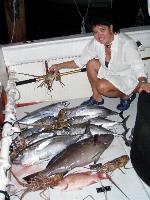 After lunch we ran out to
the hump, and chummed up the tunas where Elena caught 15 tunas, hooking
double headers. She caught one 15 lb. black fin tuna, and lost a couple
others that size. We kept 7 black fin tuna and two skipjacks and let the
others go. On the way home we stopped off at a lobster spot and got 6
lobsters - what a great half day! I canned most of the tuna (20lbs.) had two
dinners of grilled tuna, two dinners of grouper, one of lobster, made a huge
grilled tuna fish salad for the week, and froze the rest for my parents. After lunch we ran out to
the hump, and chummed up the tunas where Elena caught 15 tunas, hooking
double headers. She caught one 15 lb. black fin tuna, and lost a couple
others that size. We kept 7 black fin tuna and two skipjacks and let the
others go. On the way home we stopped off at a lobster spot and got 6
lobsters - what a great half day! I canned most of the tuna (20lbs.) had two
dinners of grilled tuna, two dinners of grouper, one of lobster, made a huge
grilled tuna fish salad for the week, and froze the rest for my parents.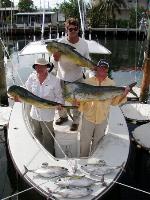
Had a few days where I took
clients out dolphin fishing, and caught all the heavy lifters and gaffers
that we wanted along with a few black fin tuna to start the day. One day I
chummed along side of two of my friends, and those tuna never left our
boats. We did a power drift up to 1.25 miles from the hump and those tunas
stayed with us for over an hour of fishing. Usually, you got to keep moving
up current of the hump and go past the fish getting them fired up to eat the
livies on the surface. I guess we just had so many pilchards going into the
water the followed us. When one of my friends took off to go dolphin
fishing, they started to dissipate.
Inshore fishing: has
been just as good for snook, tarpon, bonefish, permit, and
mangrove snapper too.
Dave Dekker and Jeff Maron
of Palm Coast, FL had a great couple days fishing. They came down for one
day offshore, which they caught all the dolphin they wanted - they actually
said "we've had enough!" But they really wanted to fish for bonefish and
permit, and did we also have a great day bonefish fishing. We started out
chumming, and caught three bonefish on jigs: 5, 2, 2 lbs. We then went
looking for permit but had no luck, but it was raining and cloudy with poor
visibility. That was disappointing because the week before in the same spots
I saw over one hundred permit from singles to triples, to schools of 15 to
30 permit in 2.5 hours fishing. My clients had one bite, and missed it by
"Bill Dance'ing the strike." Unfortunately they never saw any of the permit
they were casting at, so no other bite occurred. So I told Dave and Jeff
lets go look for some tailing bonefish, and did we find the tailing
bonefish.
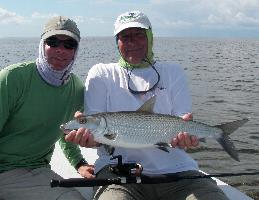 They caught 3 more bonefish
sight casting to 5 different schools of tailing bonefish up to a dozen or so
in each school. They were from 4 - 8 lbs. The big one did not even make the
longest run, but fought closer to the boat staying with the other bonefish
that had spooked but not gone far. One of the smaller bones made a 130 yard
run across the flat which really impressed these two "bull redfish"
fisherman. They caught 3 more bonefish
sight casting to 5 different schools of tailing bonefish up to a dozen or so
in each school. They were from 4 - 8 lbs. The big one did not even make the
longest run, but fought closer to the boat staying with the other bonefish
that had spooked but not gone far. One of the smaller bones made a 130 yard
run across the flat which really impressed these two "bull redfish"
fisherman.
Jeff Dahl from Wyoming had
a great first 2 days saltwater flay fishing the back country for tarpon and
snook. He did not catch any of them, but he hooked some nice fish and had
plenty of bites. The first fish he hooked was about a 5+ pound tarpon and he
got two jumps before it got off. He jumped another one off that day, and
jumped a snook off too. He had numerous other bites from snook and tarpon,
then at the end of the day he want to see how it was done, so I caught one
and brought it to the boat so he could see it and take a picture. They next
day we fished 3/4 day the same thing before his wrist gave out from the
casting. Again he had numerous bites, including one big snook that just
exploded on his popper coming almost half way out of the water. All these
fish were eating poppers or surface streamers, so every bite was on the
surface. First day there were a lot of baby tarpon, and the second day was
mostly snook bites. The last two hours we fished mudding rays to catch jacks
or redfish, but the rays had lots of small snapper on them. He caught a
couple snapper and missed a couple jacks, but at least he got the experience
in sight fishing and saw how different it really is from his trout fishing.
On the way home I convinced him to stop and fish for small sharks, even
though he was very tired with the heat and casting for two days. We had a
few shots at lemon and bonnet head sharks, which he missed a bite by using the
old trout strike of lifting the rod tip. This is one of the biggest
handicaps all trout fishermen have, and also dealing with a moving target.
To cap it off as we were polling off the flat we came across a tailing
permit up on the flat. What a classic sight! He said he cannot wait till
next year.
Rick and James Ovelman from
Miami came down for a couple days of snook and tarpon in the back country.
Both days Rick caught a tarpon on fly and thoroughly enjoyed it. We talked
old stories about fishing with legendary Bill Curtis, which was the last
time he caught a tarpon on fly many years ago. Now he would rather catch
smaller fish. James had numerous shots at some big tarpon in the 40 - 80
pounds for about 2 hours the first morning. We found them laid up and
rolling in one of the basins back there. James and Rick caught numerous snook back there, and the last day they may have caught close to 15 and
missed just as may bites. James was on it for a while, almost every cast he
was hooking a snook. All of them were just under the slot, but we lost one
at the boat that was definitely a keeper. Once again we had a great couple
days fishing together, they have been fishing with me for years now, always
for the big spring tarpon with live bait. But they have always talked about
back country fishing, and I'm glad they finally got down here for this Sept.
fishing.
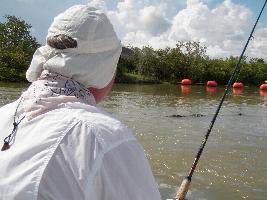 Next James talked about
canoe trip, but Rick still seems a little concerned, especially after the
10' crocodile that was hanging around while we caught snook. Next James talked about
canoe trip, but Rick still seems a little concerned, especially after the
10' crocodile that was hanging around while we caught snook.

MONTHLY FISHING
FORECAST
MARCH
March is a transition month. The spring
fishing starts up on mild days and yet we can still have strong cold fronts
making for winter conditions. It can be frustrating for some; you just got
to be ready to go to a plan “B” or “C.”
INSHORE FISHING:
"The big tarpon" start to
show up in enough numbers that you can fish for them on a daily basis, as
long as the water temperature is over 70 and better yet mid 70’s. We catch
most of our largest tarpon in March (140 – 200 lbs.), which is a great
counterpoint to the fact that we typically do not catch as many tarpon per
day as during the peak tarpon season. However a couple years ago we caught
54 tarpon in the first ten days of March. Tarpon fishing is totally
dependent on the immediate weather we have. If we get a warm spell, keeping
the water in the 70’s, we will have excellent tarpon fishing. Once a cold
front comes through, and drops the water temperature the tarpon will move
out to deeper warmer water or just hunker down on the bottom in a slumber of
slower metabolism due to the cooler water. This is when you go to plan “B”
or “C.”
Permit and bonefish fishing is excellent
this month on the flats. You can find big schools of permit on the edges of
the flats and in the channels. This is an excellent time of year to fly fish
for permit too. With the typical windy days, you can get closer to them for
a more accurate cast, and they can be more aggressive too. The bonefish will
be in mudding and tailing vigorously if the water stays above 70 degrees.
Snook, redfish, and trout will all be very good in the backcountry too.
“Plan B” can be a couple different
options. First preference for me would be to go sailfish fishing along the
reef. While sailfish fishing we can catch other great pelagic fish like
kingfish, wahoo, black fin tuna, cobia, and dolphin, or stop along the reef
or one of the local wrecks for grouper and snapper. However, some anglers do
not take well to the offshore seas, so plan “B - 2” might be fishing the
patch reefs for snapper, grouper, hogfish, porgies, mackerel, barracudas,
and small sharks. Or we could go fishing Gulf of Mexico for Spanish
mackerel, snappers, groupers, cobia, bluefish, and big sharks.
Another option “Plan C” I’ve been
enjoying more the last couple years, has been fishing for big sharks in the
channels through the flats in crystal clear waters. One of the draws to
tarpon fishing is that you can catch big fish pushing 200 lb., and not have
to go offshore in rough seas. So when the tarpon are not cooperating, big
sharks (up to 300lbs.) is an exciting option. Often we can see three or more
of these brutes swimming around behind the boat searching for our baits in
water as shallow as three feet deep. Talk about “edge of your seat” thrill.
Sporty black tip sharks up to 125 lb. can charge in across the surface
throwing water everywhere attacking a live bait on the surface suspended
from a kite, followed by blistering runs and frantic spinning jumps clear
out of the water. Even bull sharks up to 300lb. like to attack those live
baits, but also take cut baits on the bottom. If we got the wind going with
the current, I’ll put up the kite with live baits along with a couple cut
baits on the bottom. The big lemon sharks, up to 300lb., typically go for
the cut baits on the bottom, and it is fun watching them swimming around
dialing in on the sent of the bait, sometimes 3 or more behind the boat
simultaneously. Last year a father and his sons were fighting a 70 lb. lemon
shark and just as we got it close to the boat a 500 lb. hammerhead shark
charges across a 2’ shallow flat with half it’s back out of water and large
tail thrashing water 15 – 20 feet side to side. The lemon shark spooks
running from the boat 30 yards, and the hammerhead shark pounces on the
lemon shark like a tiger on a pig. In a few big swirls in 5’ of water, it’s
all over! You should have heard the screams by those young kids and their
dad. They said they are definitely coming back.
First we catch a few big barracudas,
which a lot of anglers really enjoy more than they anticipate. While slow
trolling live baits on the surface, you get a pretty exciting bite from
these barracudas. They fight well and often make a few good jumps, sometimes
almost hitting the boat. We have actually caught mutton snapper doing this
and once I had about a 50 lbs. jewfish blast one of our baits coming
completely out of water and flipping upside down on the strike. That was a
jaw dropper! Unfortunately it was a one time strike. It missed the bait
completely, and never came back for a second hit. Boy, did I want to get
another hit like that and catch that fish.
Then we head out back to go shark
fishing. We butterfly fillet the barracudas down to their tail and hang them
over the side one at a time for chum. We cut a couple strip baits from the
fillets and put them in the chum line. I will also fish a couple live baits
too which also makes for an exciting strike on the surface. A lot of times
within 10 minutes you get a strike. If it’s a nice shark (80lbs. lemon, 50
lbs. black tip, or 50 lbs. bull shark) it will make a nice 100 yard or more
run, and fight hard around the boat. If you hook one bigger than that, you
got to chase them with the boat. Black tip sharks make spectacular spinning
jumps and fight very hard for their size. A 100 pounder will kick your butt
for 45 minutes or more. Once you get them up to the boat to release them,
they will impress you with their tenacity in their last effort for freedom.
I hold the leader and the dorsal so you can get a good picture with them
while they are in the water. I use to lift them up the side of the boat with
a gaff, but they just really hurt themselves by struggling so much and
spinning around. Typically we catch them in 15 to 30 minute fights. It is
not typically long drawn out battles because we are fishing in shallow water
and can get right over them and apply maximum direct pressure.
OFFSHORE FISHING:
Sailfish are coming toward the end of
the season, but that does not mean it will becoming slow. Actually we can
have some of the year's best fishing now, especially if there are “tailing
sailfish” on the “powder line.” An unusual condition in the spring, where we
“sight fish” for sailfish (and cobia) as they are surfing the waves from the
East into a strong North current with a definitive “powder-blue current
line” from the shallows that gets pushed out into the blue water. Here the
sailfish surf the waves until they hit the “powder line” then the sailfish
follow it. We search the line waiting to cast baits right to a sailfish or
more as they come down the “powder line.” It is incredible. This is when
some of the most sailfish are caught in a single day. Some charter boat
greats have caught over 20 sailfish in a day, awesome!
Black fin tuna of 15 to 30 lbs. will
start showing up on the local humps. Grouper and big muttons snapper are on
the areas wrecks and reefs. Yellowtail snapper can always be found on the
reef, and the big mangrove snappers (3 – 5 lbs.) will be migrating out from
the bay through the bridges out to the patch reefs and finally to the outer
reefs. I just started seeing them under my boat at the slip, so they are on
the move. If we get some summer type days for a week or so, even some early
dolphin will be coming through. Mostly small schoolies, but you could luck
into a nice “gaffer” sized fish or even a “slammer.”
FEBRUARY
February is the
middle of sailfish season here in Islamorada offshore, and the rougher
it is – the better it can be, so do not get discouraged. The sailfish is the
primary target this time of year, but we have a lot of other great offshore
fish to fish for too. This time of year we catch wahoo, black fin tuna,
kingfish, dolphin, and cobia offshore. On the reefs, wrecks, and the patch
reefs the bottom fishing can be very good this time of year too. There are
some hard fighting, good eating fish on the reef like mutton snapper,
yellowtail snapper, mangrove snapper, lane snapper, hogfish, porgies, black
grouper, red grouper, and cero mackerel. Last month’s offshore forecast
applies to this month’s forecast, so I will include that later if you missed
it last month because it is quite detailed on the way we fish and for what
we fish this time of year.
INSHORE FISHING:
In February as spring
approaches, we can get some very nice warm days out there. This makes the
first waves of big tarpon show up in the Everglades and even out
along the bridges and channels. We all wait for the big tarpon to show, so
if it is warm for a few days, we give it a shot. Every year I am catching
our first tarpon in the third or fourth week of February. Tarpon has become
my favorite sport fish. They are the largest sport fish here in the Florida
Keys, that you can catch on a daily basis. Aside from the occasional blue
marlin or if you go out to catch a swordfish, the tarpon is our biggest
fish. They range from 30 to over 200 pounds, and average around 70 to 125
pounds.
Tarpon
are also a huge challenge to hook and catch. Most people have heard about
how hard it is to hook one, because they have a very boney mouth. They also
are notorious for throwing the hook or breaking you off as they make their
first jumps. We like to have the clients bow the rod to the fish as it jumps
to keep it from spitting the hook or breaking the line.
Then they make their
first long run with a few good jumps and “we’re off to the races!” We
literally race after the tarpon with the boat, weaving through pilings and
lobster trap floats, keeping close to the fish so as not to allow the line
to get cut by an obstruction. This is very interesting twist to our tarpon
fishing here in Islamorada, and it is one of the things I really love about
tarpon fishing here. Once we get away from the bridge and any other
obstructions, we fight it like any other fish: follow it and allow the
angler to apply maximum pressure.
We try to get the
tarpon up to the boat for a quick picture of it in the water
along the side of the boat with the angler along the gunwale admiring his
tarpon in the upper corner of the photo. This way we do not have to lift the
tarpon up out of the water, which is illegal to do now. I have been doing
this for years before the new law of last year. The main reason was so I
would not hurt my back, and put me out of work. The purpose of the law was
so as to not hurt the tarpon, which is most likely true because the bigger
they are the harder it is to handle them gently for a good release after the
picture. Bringing in a big fish most times gets dragged across the gunwale,
taking a lot of protective slime off the fish. They also might drop into the
boat after the picture, then slap around hurting themselves more and
prolonging their time out of water because it is so hard to get a hold of
them to get them back in the water. The law was initially formed because the
scientists say it is very harmful to a big fish’s inners and its skeleton,
but I have to disagree from my years of observation of thousands of fish
after release. Sometimes I have followed tarpon for more than 30 minutes
after a release, because I was using the boat to fend off a big hammerhead
shark. Most of the time the tarpon will resuscitate within 15 minutes to a
point that the shark can not get it. I know when the tarpon gets away,
because it is very obvious when it does not, even if it takes 15 minutes for
the shark to track down that tarpon and it is a mile or more away. Later I
will go over some good pointers on releasing all fish.
These early spring
conditions can also make the permit school up in big numbers on the
edges of the flats. I’ve had numerous days where we have seen a few hundred
permit in numerous schools. I’ve also had two different days where we have
seen around a thousand permit moving along the flats. One of those days
there was a school of more than 300 permit, and numerous schools from 50 to
100. These were all different schools because the were migrating to the
north along the flats. At times I could see 3 schools at a time coming
towards us.
Same goes for the
bonefish. They can get into some big schools mudding along the deeper
edges of the flats waiting to move up onto the crowns to feed and tail. I
have seen schools of 100 bonefish, but that is rare. They are mostly 50 and
less, and more common one to two dozen bonefish to a school of “mudders.”
This is a great time to cast at and hook bonefish because they are
aggressively feeding and in deeper water (2 to 5 feet) which makes them not
as spooky - easier to get a bait to!
The same goes for
redfish back in the back country of Flamingo, Everglades National Park.
They will start to flood the flats as the water warms. They can sometimes
move in schools of 50 or more fish, but most of the time they are spread out
in small groups or pairs or singles. Snook fishing is also very good
this month, whether it is cold or warm. When it is colder they will be in
the deeper water and as it warms they will come out onto the flats and along
the shorelines.
February is the last
good month of Spanish mackerel fishing out just west of Florida Bay.
That is once March comes they get sporadic, unless we get a cold spell for a
few days. This is fun rod bending action, and you can catch big mangrove
snappers in the chum line and even a cobia or nice size sharks too.
How I like to release fish:
First, do not remove the
“protective slime.” Make sure your hands are wet before you grab the fish.
Then, do not bear hug the fish against your dry clothing, hold it away from
you a little.
Second, do not let it
fall onto the deck. If you can not keep a good hold of its lip with your
hand, use one of those lip holding devises. If the fish shakes violently, it
will not fall to the deck. Also holding it over the water can be a good
picture with you looking at it and your buddy taking a shot of it from
behind your shoulder to the side. If it shakes from your grip it falls into
the water, just keep the hook in its mouth. If it is barely hooked, you can
re-hook it in a secure place of its mouth, if it is a real nice fish you
definitely need a picture of. Just remove the hook after.
Third, If the fish is to
big to handle in this manner, leave it in the water along side the boat. Get
the boat moving forward at a good speed for the fish so that it is being
ventilated while you are taking the pictures. It will also keep the whole
fish up along the surface for a picture of its complete length and size. Do
not bring a big fish into the boat and put it across two or three people’s
laps. This is a big “de-sliming event.”
Fourth, get water moving
over their gills. The easy way is with the boat moving forward, or anchored
in current. Other wise the back and forth motion works most of the time and
when you let go of them shake their tail which wakes them up and makes them
dart off thinking something bit them, making them swim and ventilate more.
For a tarpon, or long fish, I tap them hard near the base of the tail, which
also makes them dart off.
Fifth, for the last 15
years I have been holding my fish upside down while reviving them
(except billfish). This immobilizes the fish, almost putting them to sleep,
putting them in a technical state of "tonic immobility." This I learned back
in the late 70's while conducting TI experiments on lemon sharks for Dr.
Samuel Gruber at the UM. I have applied this to releasing our fish. The fish
will not struggle or fight against you, instead they will relax and their
jaw will open wide open allowing maximum ventilation. While doing this I
always move the fish left and right in a swimming motion. I think this help
their blood circulation and also gets their gill plates opening from side to
side. As they get more oxygen and revive, their fins will start to flick and
they will start to swim and struggle. That is when I roll them over, and I
keep the swimming motion (left and right). When they start to resist your
swimming motion, that is when I let them go and give them a shake or strong
taps at the base of the tail. You should see them dart off with real energy.
It is very satisfying!
When reviving billfish,
I hold the bill and the front stiff section of the dorsal keeping the fish
upright. I will continue a swimming motion (left and right), until the fish
starts to resist my efforts. That is when you push the fish down with your
hand that was holding the dorsal. Try to tap the base of the tail or aft
part of the fish as it goes down. It is important to push the billfish down
to deeper cooler water. There is more oxygen in cooler water especially if
it is calm.
Sometimes, I’ll lift a
sailfish up by the bill and the sail and rest its mid section on the
gunwale, without dragging it across the gunwale. I do not let the angler hug
it or get it on his lap. I try to get the angler on the inboard side of the
fish so I am up against the gunwale with the fish. After two quick shots I
lift it straight up, so as not to slide the fish across the gunwale, and put
it back in the water as the boat has been going forward the whole time. This
way the fish is being ventilated immediately, and we can get some more
picture with the angler watching his fish being released. I would not try
this with a marlin of over a hundred pounds. Its weight would not be good on
its gut, and I have not lifted fish over 60 pounds in a long time so I do
not strain my back. Fish of this size should be left in the water for a
picture.
OFFSHORE FISHING:
The following is exactly
what I wrote for January’s forecast, and it applies to February. So hear it
is if you missed it last month.
February is peak
sailfish season, which runs from late November until late April, depending
on the weather conditions. Most of the local Islamorada charter boats love
pitching frisky ballyhoo or cigar minnows at sailfish that are chasing the
schools of ballyhoo on the reef. They also sight fishing for cruising
sailfish over the sand inside of the reef or on the reef itself. These
sailfish are looking for a school of ballyhoo, and will often take a well
cast, frisky bait. However, kite fishing with live bait is also very
effective when the conditions dictate. I have seen more local boats fishing
the kite in the last few years too. It really is a more popular technique
from Miami north up to Palm Beach, mostly due to the fact that they do not
have the schools of ballyhoo over a shallow barrier reef like we have down
here in the Florida Keys.
I grew up sailfish
fishing with the kite with my Dad since I was eight years old up off of Key
Biscayne, and it has a special spot in my heart. I still have his oversized
kite reel he built out of plywood and a long dowel. It cranks in over three
feet per turn. I had to fiberglass it up a few years ago, because the spool
started to split under the stretch of the mono. It’s a classic that usually
draws a comment or two. It’s not the high tech electric reel setups of
today, but it does not fail. Like a friend of mine lamented a couple of
years ago. His electric reel failed while the kite was out in 20 knots of
wind. He had a hell of a time getting the kite back in by hand, especially
since it had Spectron as the main line.
A lot of guys fish two
kites with three baits suspended from each kite. That is six baits out down
wind. These kites are flown left and right by putting a large split shot on
the corner you want it to fly to. It takes a bit of adjustment. Try to get
them to fly low too, so there is less slack after the bite when the line is
released from the clip. I’ve seen excellent crews fish a third kite down the
middle. Combine these kite baits with chumming with live pilchards, and you
got a fishing machine! While we are kite fishing for sailfish we can catch
other pelagic fish like black fin tuna, kingfish, dolphin, cobia, and wahoo.
One of the bonuses to
kite fishing is we can fish the bottom for big groupers and snappers
simultaneously. Typically, we are drifting while kite fishing. Some guys use
a big sea anchor to slow the drift and keep the bow into the sea. Others
drift beam to with flat lines and bottom lines out on the windward side of
the boat. There are some deeper reefs, drops, ledges, and wrecks that hold
these fish. We will plan our drift and maneuver the boat so as to go over
them to make a good pass with the bottom baits. A lot of these spots hold
bait on top like runners which also attract sailfish and the other pelagic
fish. Sometimes you can simultaneously hook up a snapper or grouper on the
bottom and a sailfish on the surface.
Another popular way to
kite fish, which a lot of local charter boats in Islamorada do, is to anchor
on the edge of the reef. They are primarily chumming for reef fish like
yellowtail snapper, mutton snapper, big grouper, and cero mackerels. They
then put out the kite to catch a sailfish, big kingfish, cobia, or whatever
other pelagic comes up the chum line.
More detail on the
techniques and description of sailfish fishing is in my web site
under the link in the right column: SAILFISH
“Wahoo are found by
mostly fast trolling with lures, plugs, or rigged ballyhoo behind big cigar
leads just outside the reef line from 180 to 300 feet deep. If you know
spots where they concentrate, you can fish for them with big speedos or blue
runners by slow trolling. Wahoo up to 50 plus pounds are caught every year,
but most of the wahoo are 25 to 35 lbs.”
“The patch reefs come
alive this time of year too. You could make a living fishing these spots
during the winter season. What a variety of fish you can catch there. The
targets are decent size mutton snapper from 5 to 15 lbs. and keeper size
groupers: blacks, gags, and red groupers. We also catch hog fish, mackerel
(cero and Spanish), snappers (yellowtail, mangroves, and lane snappers),
jacks, barracudas, and sharks for a fun rod bending experience. You can also
get a nice cooler of fish fillets to take home or to a local restaurant for
a smorgasbord of a meal. Usually they will prepare the fish three different
ways.”
“Trolling for grouper is
also a good way to catch them in the winter if the water is clear. Big
lipped magnum plugs, bonita lures, heavy skirted lures, and rigged de-boned
ballyhoos are favorite rigs. They are trolled with wire lines or heavy
braided lines with either heavy cigar leads or big planners to get the bait
down to where the grouper will dare to leave their lair to eat a bait
trolled by.”
JANUARY
“Offshore Fishing” and our “sailfish season” is by far the highlight of Islamorada,
Florida Keys fishing this month. January is typically the coldest month of
the year, and these cold fronts push the sailfish down the reef following
the schools of bait fish. While we are sailfish fishing, we catch a lot of
other great sport fish that run along the reef which would be wahoo, black
fin tuna, kingfish, dolphin, and cobia. The reef, wrecks, and the patch
reefs are great this time of year too, and can be a fun filled day of rod
bending and taking a cooler of fish home. There are some hard fighting, good
eating fish on the reef like mutton snapper, cero mackerel, yellowtail
snapper, mangrove snapper, lane snapper, hogfish, porgies, and the “big
super stud” of the reef - the black grouper.
However, once again
the grouper harvest has been prohibited by the
“tyrants” at NATIONAL
MARINE FISHERIES SERVICE (NMFS of NOAA). I’m still going to
include it anyway so you all can see how it negatively impacts our fishing
and business here in the Florida Keys. Some charter fishermen primarily
focus on the winter bottom fishing for grouper and snapper. Their clients
book them for a fun filled day of serious rod bending on the reefs, and to
take some great eating fish home too. For many other charter boats, a big
grouper or two is a great bonus while we are fishing the reefs and wrecks
for a multitude of other sport fish down here in Islamorada. What makes this
a “particularly offensive outrage,” is that this “blanket grouper
prohibition” is designed specifically to protect the “gag grouper,” which
has never been a prominent grouper down here. Even though that point was
stressed at the public hearings and further concessions of limiting our
catches were offered, the “NMFS TYRANTS” apparently just turned their backs
on the citizens they are supposed to be working for. That’s right folks,
just another encroachment on our freedoms and our “life, liberty,
and pursuit of prosperity” (for our families!) by
appointed bureaucrats! I’ve
even seen publications stating other Florida university scientists
contradicting the NMFS scientist’s data on gag grouper populations as being
way underestimated due to their methods of estimating. What the hell is
this? A regulatory crap shot with our livelihood and wellbeing. I find this
especially heinous in the face of a serious economic down turn!
Anyway, as I started on
the inshore fishing and the exciting “sight casting” to big barracudas on
the flats, I remembered a funny story while I was a mate 20 years ago. It
starts with: It’s
one of my greatest memories as a young man – saving a “really hot chic!”
I think veteran and novice anglers will enjoy this brief
story. Since inshore fishing is considered at its most difficult due to the
cold weather, I did not want the reader to miss a good laugh by glancing
over that section, expecting the typical winter inshore forecast. Even
though inshore fishing can be tough this month on those cold days, we know
how to change tactics to catch fish. Sometimes we can have some action
packed days as the fish stack in the deeper, warmer water in the creeks,
channels, canals, motes, and basins. It’s just not the conditions for the
classic sight fishing on the flats, unless you get a warm spell for a few
days with 70 degree water which will bring the fish back up on the flats.
OFFSHORE FISHING:
January is getting
into peak sailfish season, which runs from late November until late April,
depending on the weather conditions. Most of the local Islamorada charter
boats love pitching frisky ballyhoo or cigar minnows at sailfish that are
chasing the schools of ballyhoo on the reef. They also sight fishing for
cruising sailfish over the sand inside of the reef or on the reef itself.
These sailfish are looking for a school of ballyhoo, and will often take a
well cast, frisky bait. However, kite fishing with live bait is also very
effective when the conditions dictate. I have seen more local boats fishing
the kite in the last few years too. It really is a more popular technique
from Miami north up to Palm Beach, mostly due to the fact that they do not
have the schools of ballyhoo over a shallow barrier reef like we have down
here in the Florida Keys.
I grew up sailfish
fishing with the kite with my Dad since I was eight years old up off of Key
Biscayne, and it has a special spot in my heart. I still have his oversized
kite reel he built out of plywood and a long dowel. It cranks in over three
feet per turn. I had to fiberglass it up a few years ago, because the spool
started to split under the stretch of the mono. It’s a classic that usually
draws a comment or two. It’s not the high tech electric reel setups of
today, but it does not fail. Like a friend of mine lamented a couple of
years ago. His electric reel failed while the kite was out in 20 knots of
wind. He had a hell of a time getting the kite back in by hand, especially
since it had Spectron as the main line.
A lot of guys fish two
kites with three baits suspended from each kite. That is six baits out down
wind. These kites are flown left and right by putting a large split shot on
the corner you want it to fly to. It takes a bit of adjustment. Try to get
them to fly low too, so there is less slack after the bite when the line is
released from the clip. I’ve seen excellent crews fish a third kite down the
middle. Combine these kite baits with chumming with live pilchards, and you
got a fishing machine! While we are kite fishing for sailfish we can catch other pelagic fish
like black fin tuna, kingfish, dolphin, cobia, and
wahoo.
One of the bonuses to
kite fishing is we can fish the bottom for big groupers and snappers
simultaneously. Typically, we are drifting while kite fishing. Some guys use
a big sea anchor to slow the drift and keep the bow into the sea. Others
drift beam to with flat lines and bottom lines out on the windward side of
the boat. There are some deeper reefs, drops, ledges, and wrecks that hold
these fish. We will plan our drift and maneuver the boat so as to go over
them to make a good pass with the bottom baits. A lot of these spots hold
bait on top like runners which also attract sailfish and the other pelagic
fish. Sometimes you can simultaneously hook up a snapper or grouper on the
bottom and a sailfish on the surface.
Another popular way to
kite fish, which a lot of local charter boats in Islamorada do, is to anchor
on the edge of the reef. They are primarily chumming for reef fish like
yellowtail snapper, mutton snapper, big grouper, and cero mackerels. They
then put out the kite to catch a sailfish, big kingfish, cobia, or whatever
other pelagic comes up the chum line.
More detail on the
techniques and description of sailfish fishing is in my web site
under the link in the right column: SAILFISH
Do not forget about
the wahoo fishing and patch reef fishing I wrote about last month which is
winter fishing in the FL Keys. I’ll even include “trolling for grouper” from
last month, because before the “NMFS TYRANTS” outlawed grouper, it was a fun
way to spend an hour or so if the sailfish fishing was slow and the charter
did not want to fish for yellowtail snappers because they wanted to catch
something “big!”
“Wahoo are found by
mostly fast trolling with lures, plugs, or rigged ballyhoo behind big cigar
leads just outside the reef line from 180 to 300 feet deep. If you know
spots where they concentrate, you can fish for them with big speedos or blue
runners by slow trolling. Wahoo up to 50 plus pounds are caught every year,
but most of the wahoo are 25 to 35 lbs.”
“The patch reefs come
alive this time of year too. You could make a living fishing these spots
during the winter season. What a variety of fish you can catch there. The
targets are decent size mutton snapper from 5 to 15 lbs. and keeper size
groupers: blacks, gags, and red groupers. We also catch hog fish, mackerel
(cero and Spanish), snappers (yellowtail, mangroves, and lane snappers),
jacks, barracudas, and sharks for a fun rod bending experience. You can also
get a nice cooler of fish fillets to take home or to a local restaurant for
a smorgasbord of a meal. Usually they will prepare the fish three different
ways.”
“Trolling for grouper
is also a good way to catch them in the winter if the water is clear. Big
lipped magnum plugs, bonita lures, heavy skirted lures, and rigged de-boned
ballyhoos are favorite rigs. They are trolled with wire lines or heavy
braided lines with either heavy cigar leads or big planners to get the bait
down to where the grouper will dare to leave their lair to eat a bait
trolled by.”
INSHORE FISHING
When it is too cold
for bonefish, and permit on the flats, one of my favorite fish to
sight cast too is the “great barracuda.” As we pole the edges of
the flats looking for a bonefish or permit during borderline temperatures,
we typically will see plenty of barracudas. The bigger barracudas in the 20
to 25 pound class are generally solitary fish or in pairs. They will be laid
up on the white spots or hanging down current of sea fans, gorgonians, or
Sargasso weed strings attached to the bottom. They can also be cruising down
the edges of the flats too. We will also encounter schools of a dozen
barracudas or more, but they are typically smaller in size, say 3 to 15
pounds.
Barracuda attack the lures with startling aggression,
and can make a few strong runs with some good jumps sometimes over 6 feet
high or 20 feet across the water – great action when things are slow on the
flats. Tube lures are my favorite lure. They are erratic and resilient to
many bites. Surface plugs are good too, but try to find the ones that are
solid foam or wood. The hollow plastic ones will get punctured and ruined.
Casting to and hooking
these fish is not a sure thing! You have to have an accurate cast. If you
cast too close you’ll spook them. Too far away and they will never see it.
As you are casting, do not let them see the shadow of the lure, or you
casting at them. The first cast or two really has to count.
I like to cast beyond
their area of detection (20 plus feet) then bring it into their field of
view (10 – 15 feet) at a moderate speed. When they make a move at it, this
is when you work it a little faster. If they don’t hit it then, go faster.
If they don’t hit that, go faster yet and more erratic. I like to explain it
as gears in a car, first through fourth. Start out in first. Sometimes they
won’t give you a chance to get into second gear. Or they attack it right at
the boat, just as you are reeling as fast as you can!
Hold your rod to the
side though. Often they explode on a fast moving bait, and you would not
want their follow through to come right at you. I’ve never had one come in
the boat like this, but I did have one come in the boat while we were
yellowtail snapper fishing off Cat Cay, Bahamas.
It’s one of my greatest memories as a young man – saving a “really hot
chic!” I was the
second mate on the “Knightlines,” and we were taking a break from slow blue
fin tuna fishing off of Cat Cay, Bahamas. The yellowtails were chummed up,
and I was unhooking fish and baiting hooks – BAM! There’s a big crash
behind us. Wheeling around I find a four foot barracuda snaking wildly
across the cockpit right towards the boss’s utterly “drop dead gorgeous”
girl friend, dressed in a very tight string bikini, fully endowed. She is
screaming hysterically as she gets cornered by this big barracuda. Now’s my
chance!
I hop over the
barracuda, pick her up, and hop back over the barracuda! From total panic to
total elation, she whips around and jumps on top of me, scissoring my waste
and hugging me. She buries my face in her bikini top and suntan oil
screaming “thank you, thank you, thank you!” Shocked, I withdraw my face
“first excited, then panicked” thinking of the boss’s disapproval. She
kisses me several times on each cheek. Stoked, with a big grin I fearfully
peek up to the bridge and see the boss and captain having a big laugh. What
a relief. They probably are still laughing over the look on my face.
Needless to say, she never got too close to me again, though I always saw a
twinkle in her eye for the rest of that trip and dreamed of the
possibilities!
Now the flats fishing
scenarios for January are the same as for December, and this is what I wrote
about pursuing all of our fish during the different types of conditions we
have during the winter months.
We can still have some
spring like days in between the cold fronts. These days are good for flats
fishing for bonefish, permit, barracudas, and sharks on the ocean side
flats. And back in the back country the redfish, snook, sea trout, jacks,
and sharks will be on the flats too. But after a cold front we have to
change our strategy, and fish deeper water where these fish will be seeking
warmer water. The water temperature changes quickly on the shallow flats
where the strong, cold wind cools the water fast, like a radiator. So all
the flats fish will be in the channels, creeks, deeper basins, or deep water
edges of these flats.
In these conditions
bonefish will be mudding and cruising in areas three to five feet deep. We
can pole the edges of the flats looking into the deeper areas for schools of
bonefish mudding or schools cruising by, then pole out to intercept them
with a cast. Some guides like to soak shrimp on three to five rods in areas
where they are known to cruise by. This can be very effective in catching
winter bonefish and a multitude of other flats fish for a rod bending fun
day. Other guides like to throw handfuls of chop shrimp in the area then
bind cast a shrimp tipped jig through the area. This is also a great way to
catch cold water bonefish along with the other rod benders.
The redfish, snook,
baby tarpon, sea trout, ladyfish, jacks, and sharks will congregate in the
deep channels and creeks when the water gets chilled by a cold front. There
can be some bang up fishing when the fish pack it in there. Sometimes it can
be as fast as you can put a bait in the water. Pilchards, pinfish, and
shrimp tipped jigs are used. Keep in mind that snook season is closed Dec. –
Feb.
Sea trout, ladyfish,
and jacks will school up in the mullet muds in numerous basins around
Flamingo. This is always a fun rod bending time. Kids love to do this.
Remember, trout season is closed until the first of the year.
The Spanish mackerel
will be hot and heavy just west of the inter-coastal waterway within 5 miles
out. Take a few blocks of chum, live shrimp, pompano jigs, pilchards,
spoons, lures, and flies – they will eat it all once you got them chummed up
behind the boat. Often you will get mangrove snapper chummed up to, along
with the sharks, blue fish, and be ready for a cobia to show up too.
Also please take note
of what I said last month on the weather conditions during the winter here
in the Keys and dress accordingly.
Winter will have with
strong cold fronts. Temperatures can drop in to the low fifties and the
winds can be more than 25 knots for a couple days or more.
Offshore these winds
are N.N.W. to E.N.E which are essentially an offshore wind and the chop will
be 1 to 3 feet on the deep side of the reef (70’ to 200’) where we are
sailfish fishing. When the wind pulls around to the E. to S.E. that is when
it becomes an onshore wind and the seas build to 4’ to 6’ with a 20 knot
wind. It is sporty, but still very fishable depending on your experience.
These are the winds that drive the bait down the E. coast and up against the
reef. Right behind the bait are the sailfish, “late-late season” dolphin,
black fin tuna, kingfish, and wahoo. When it lays down to 10 knots out of
the S.E., it is nice fishing the edge of the reef. Big grouper and mutton
snapper fishing is very good on the wrecks and along the reef. Calmer
conditions are needed to get the baits down on the wrecks. The fishing on
the patch reefs starts to really turn on too.
Inshore, if we get one
of these cold fronts with strong winds do not let it detour you. Getting to
the fish in the back country is no real problem with the waves. We just run
the lee side of the flats and islands to get to areas that are sheltered by
the trees on the islands or mainland shoreline. I’ve been out there catching
fish with 30 knot winds blowing over the tops of the trees and virtually no
wind affecting us, while fishing!
If I decide to make a
run for it, I will have a full ski mask and gloves on over my heavy foul
weather gear. We have no protection from the wind in our skiffs and often we
are running right into it at 30 to 40 knots. That is more than 55 knots of
wind. I do not know what the wind chill factor is, but it is damn cold
especially after running 45 minutes into the back country. Then you take a
shot of spray a couple times - burr! Do not forget to dress appropriately is
my point, because the fish are still biting.
Capt. Rick Killgore
(For
all fish reports, click on
All Florida
Keys Fishing Reports)
DECEMBER
December is the month all the offshore fishermen are waiting for. “It is
sailfish season!” Winter has arrived with strong cold fronts. Temperatures
can drop in to the low fifties and the winds can be more than 25 knots for a
couple days or more. Conversely, this is not the season the flats fishermen
are looking forward to. If I decide to make a run for it, I will have a full
ski mask and gloves on over my heavy foul weather gear. We have no
protection from the wind in our skiffs and often we are running right into
it at 30 to 40 knots. That is more than 55 knots of wind. I do not know what
the wind chill factor is, but it is damn cold especially after running 45
minutes into the back country. Then you take a shot of spray a couple times
- burr! Do not forget to dress appropriately is my point, because the fish
are still biting.
About the foul weather conditions on the water, I’m going to paraphrase a
little what I wrote last month:
Offshore these winds are
N.N.W. to E.N.E which are essentially an offshore wind and the chop will be
1 to 3 feet on the deep side of the reef (70’ to 200’) where we are sailfish
fishing. When the wind pulls around to the E. to S.E. that is when it
becomes an onshore wind and the seas build to 4’ to 6’ with a 20 knot wind.
It is sporty, but still very fishable depending on your experience. These
are the winds that drive the bait down the E. coast and up against the reef.
Right behind the bait are the sailfish, “late-late season” dolphin, black
fin tuna, kingfish, and wahoo. When it lays down to 10 knots out of the
S.E., it is nice fishing the edge of the reef. Big grouper and mutton
snapper fishing is very good on the wrecks and along the reef. Calmer
conditions are needed to get the baits down on the wrecks. The fishing on
the patch reefs starts to really turn on too.
In between the cold
fronts we can have beautiful “spring like” days. If we get one of these cold
fronts with strong winds do not let it detour you. Getting to the fish in
the back country is no real problem with the waves. We just run the lee side
of the flats and islands to get to areas that are sheltered by the trees on
the islands or mainland shoreline. I’ve been out there catching fish with 30
knot winds blowing over the tops of the trees and virtually no wind
affecting us, while fishing!
OFFSHORE
FISHING:
This
is it, sailfish season is here! This is when the sailfish are ambushing the
ballyhoo on the reef into 20 feet of water. You can see over 500 ballyhoo
fleeing across the water as sailfish are chasing them down, numerous times a
day. They call it “showers” of ballyhoo, and it is a sight to see. We will
run up to 300 yards with live ballyhoo, cigar minnows, or pilchards ready to
throw at the slashing sailfish. Hopefully there are more than 6 sailfish in
the melee where we have a good chance to get multiple hook-ups and rack up
the releases.
This
is a very exciting way to fish for sailfish, and everyone has to be on their
toes to get it done. An accurate cast with a very fresh bait is often the
rule. Sailfish will refuse a perfect cast with a tired bait, or a perfect
bait cast off target. Then by the time you’re ready for the second cast, the
sailfish might have sensed the boat. They’ll settle down a little, stop
chasing the bait, and definitely refuse your bait. This is why you have to
monopolize your chances while the sailfish are in the heat of the moment.
Believe me this is the “Heat of the Moment” in the boat too. There can be
“overly excited directions” being vocalized by the “captain in the tower” to
the mates and anglers in the cockpit, that can be heard over a hundred yards
away. This can make for some great bar stool stories for years to come, and
I’ve got some classics. One of my favorites is the “Reel Circles, not
Squares!” story which happened while I was a mate for one of Islamorada’s
great captains.
The
Islamorada charter boats are experts in fishing the “ballyhoo showers” and
can catch up to 20 sailfish in a day, and a few have even caught more than
20 sailfish. Now do not be intimidated by my extreme portrayal of “the heat
of the moment” coaching by the captain to the team in the cockpit. Typically
everyone is very professional, it’s just at times we got to yell over the
wind and roar of the engines so all can hear exactly where the fish are to
cast at. If it seems “a little over the top” let me give you a tip, refrain
from making comparisons to Nick Saban down here in S. Florida. ;-)
If
the sailfish are not pushing the ballyhoo schools, we will be slow trolling
live baits or flying a fishing kite and drifting. While we are fishing for
sailfish we can catch black fin tuna, kingfish, dolphin, cobia,
wahoo, cero mackerel, and even big barracudas
while we are slow trolling or kite fishing with live baits. What I like
about kite fishing is we are fishing for sailfish and the other fish on the
surface with the kite and flat lines, and fishing for snapper and grouper on
the bottom with a bottom rod or a deep jig or both.
If
the sailfish are showering the ballyhoo we will be slow trolling live baits
so we can quickly charge over to the melee of sailfish without having to
bring the kite in. The cero mackerel also shower the ballyhoo and are quite
fun to catch while waiting for the next group of sailfish. They slash and
boil on the live bait we are trolling on the surface. If we get in a good
school of them we can cast lures on #10 spinners or fly rods and have some
sporty fun. They can be over 10 lbs. and are great eating.
More
detail on the techniques and description of sailfish fishing is in my web
site
under the link: SAILFISH
Wahoo show up strong in December. Wahoo are found by mostly fast trolling
with lures, plugs, or rigged ballyhoo behind big cigar leads just outside
the reef line from 180 to 300 feet deep. If you know spots where they
concentrate, you can fish for them with big speedos or blue runners by slow
trolling. Wahoo up to 50 plus pounds are caught every year, but most of the
wahoo are 25 to 35 lbs.
Trolling for grouper is also a good way to catch them in the winter if the
water is clear. Big lipped magnum plugs, bonita lures, heavy skirted lures,
and rigged de-boned ballyhoos are favorite riggs. They are trolled with wire
lines or heavy braided lines with either heavy cigar leads or big planners
to get the bait down to where the grouper will dare to leave their lair to
eat a bait trolled by.
The
patch reefs come alive this time of year too. You could make a living
fishing these spots during the winter season. What a variety of fish you can
catch there. The targets are decent size mutton snapper from 5 to 15 lbs.
and keeper size groupers: blacks, gags, and red groupers. We also catch hog
fish, mackerel (cero and Spanish), snappers (yellowtail, mangroves, and lane
snappers), jacks, barracudas, and sharks for a fun rod bending experience.
You can also get a nice cooler of fish fillets to take home or to a local
restaurant for a smorgasbord of a meal. Usually they will prepared the fish
three different ways.
INSHORE FISHING
We
can still have some spring like days in between the cold fronts. These days
are good for flats fishing for bonefish, permit, barracudas, and sharks on
the ocean side flats. And back in the back country the redfish, snook, sea
trout, jacks, and sharks will be on the flats too. But after a cold front we
have to change our strategy, and fish deeper water where these fish will be
seeking warmer water. The water temperature changes quickly on the shallow
flats where the strong, cold wind cools the water fast, like a radiator. So
all the flats fish will be in the channels, creeks, deeper basins, or deep
water edges of these flats.
In
these conditions bonefish will be mudding and cruising in areas three to
five feet deep. We can pole the edges of the flats looking into the deeper
areas for schools of bonefish mudding or schools cruising by, then pole out
to intercept them with a cast. Some guides like to soak shrimp on three to
five rods in areas where they are known to cruise by. This can be very
effective in catching winter bonefish and a multitude of other flats fish
for a rod bending fun day. Other guides like to throw handfuls of chop
shrimp in the area then bind cast a shrimp tipped jig through the area. This
is also a great way to catch cold water bonefish along with the other rod
benders.
A
great fish to sight cast to on the flats in the winter when the bonefish and
permit are looking for warmer water are the barracuda. They often will be
laid up on the white spots or hanging down current of sea fans, gorgonians,
or Sargasso weed strings attached to the bottom. Cast a tube lure or a lure
close by and crank it back fast. Hold on for a spectacular bite if you can
fool them. Get ready for a couple short burning runs and a few nice jumps.
The
redfish, snook, baby tarpon, sea trout, ladyfish, jacks, and sharks will
congregate in the deep channels and creeks when the water gets chilled by a
cold front. There can be some bang up fishing when the fish pack it in
there. Sometimes it can be as fast as you can put a bait in the water.
Pilchards, pinfish, and shrimp tipped jigs are used. Keep in mind that snook
season is closed Dec. – Feb.
Sea
trout, ladyfish, and jacks will school up in the mullet muds in numerous
basins around Flamingo. This is always a fun rod bending time. Kids love to
do this. Remember, trout season is closed until the first of the year.
The
Spanish mackerel will be hot and heavy just west of the inter-coastal
waterway within 5 miles out. Take a few blocks of chum, live shrimp, pompano
jigs, pilchards, spoons, lures, and flies – they will eat it all once you
got them chummed up behind the boat. Often you will get mangrove snapper
chummed up to, along with the sharks, blue fish, and be ready for a cobia to
show up too.
NOVEMBER
November is a great time to get out fishing here in Islamorada, both inshore
and offshore. In between the early season cold fronts we have beautiful
“spring like” days. If we get one of those early season cold fronts with
strong winds and overcast “drizzly” rainy days, do not let it detour you.
These conditions can turn certain species on. Getting to the fish in the
back country is no problem. We just run the lee side of the flats and
islands to get to areas that are sheltered by the trees on the islands or
mainland shoreline. I’ve been out there catching fish with 30 knot winds
blowing over the tops of the trees and virtually no wind affecting us.
Offshore these winds are N.N.W. to E.N.E which are essentially an offshore
wind and the chop will be 1 to 3 feet on the deep side of the reef (70’ to
200’) where we are sailfish fishing. When the wind pulls around to the E. to
S.E. that is when it becomes an onshore wind and the seas build to 4’ to 6’
with a 20 knot wind. It is sporty, but still very fishable depending on your
experience. These are the winds that drive the bait down the E. coast and up
against the reef. Right behind the bait are the “early season” sailfish,
“late season” dolphin, black fin tuna, kingfish, and wahoo. When it lays
down to 10 knots out of the S.E., it is nice fishing the edge of the reef.
Big grouper and mutton snapper fishing is very good on the wrecks and along
the reef. Calmer conditions are needed to get the baits down on the wrecks.
INSHORE FISHING
SNOOK:
The
"fall" is my favorite time to fish for snook, and my favorite place is the
back country of the Everglades National Park in the "dense mangrove creeks",
island motes, shorelines, and points. I have had days were we have caught
more than 20 snook of all sizes. A good day is catching 8 to 10 snook, along
with a few tarpon and mixed bag of other sporty fish like redfish, jacks,
sea trout, jewfish, snapper, ladyfish, and maybe even a big shark which can
account to catching more than 25 to 50 fish for the day.
Typically we use live bait to bang away at them and have a good "rod bending
blast". My favorite live baits are pilchards, finger mullet, shrimp, and
pinfish. We look for terns or pelicans diving on pilchards and mullet then
catch them with a cast net. We can also cast lures and flies at these snook,
tarpon, and other fish if that is what you like to do. They will eat top
water lures and flies which is always a blast. On those overcast days they
can hit top water lures like it’s dawn, sometimes all day. However, I do not
recommend this for the novice, the action often is not as good as using live
bait and we will miss more fish on top water too. For top water I like Zara
Spooks (large and Jr. size), Bagley’s finger mullet, and Storm’s Chug Bug.
Good colors are red and white; white, silver or copper and black back; and
chartreuse. Any plug that “walks the dog,” and is in the size range of the
others will work. For flies I like a deer hair sliders or small poppers in
the same colors as the plugs, but I do have yellow and brown back sliders
too. A little red is always good to have in the fly at the throat or nose.
They will eat all types of hard crank baits, soft baits, and jigs typically
more readily than top water lures.
We
can also fish for snook on the flats as we are fishing for redfish in the
back country. Often they will be hanging in the white pot holes, and will
attack top water flies or lures - sometimes two at a time! There can be nice
snook up to 12 lbs. They can also be cruising the flats and are also quite
spooky, but if you get your lure in front of them before they spook, they
will eat it. And what a nice run they make in shallow water, sometimes up to
75 yards. Then they come up shaking their head and you pray: “don’t shake
that hook, please just don’t shake that hook.”
TARPON:
The
big tarpon have moved on, but the juveniles stay to grow. We catch lots of
tarpon in the 5 – 30 lbs. range with the occasional 50 – 80 lbs. tarpon.
Again, the Everglades National Park is one of my
favorite places to fish for baby tarpon back in the mangrove creeks, island
motes, shorelines, and points. Quite often you can see these tarpon rolling
and busting on bait a hundred yards away. Typically we catch a few mixed in
with the snook we a fishing for. If you just want to target tarpon, we could
do that all day and really bang away at them.
We
also fish around the bridges for baby tarpon, especially if we are going to
do a little bonefish and permit fishing that day. This can be hot fishing.
We can catch up to 6 or more tarpon in a half day. We'll do about half a day
each so the angler can experience both 1) the hunt for very challenging fish
of the bonefish and permit, and 2) bend a rod at a bridge on tarpon, snook,
jacks, barracudas, snapper, grouper, and cero mackerel with live bait.
Typically we'll fish the bridges after catching bait first thing in the
morning. Almost every time we're having so much fun fishing the bridges, the
anglers do not want to leave. Then we'll take an hour or two to fish the
flats for bonefish and permit. I cannot do the reverse because it's very
hard to pole with my bait wells filled with 30 gallons of water and bait.
BONEFISH:
Some
of the biggest bonefish are caught this time of year too, because there is a
minor fall spawn. Our average bonefish is 8 – 10 lbs. with fish getting into
the 13 lbs. range. Record size bones of 14 plus lbs. can be caught.
In
November we can still find lots of “tailing and mudding bonefish” as long as
the water temperature does not have a significant drop by a cold front. Do
not get frustrated by overcast days, this is when we can chase tailing
bonefish all day. The low light is like early morning which they like for
tailing in very shallow water. We also focus on tailing bonefish in this low
light because it is very hard to see them in the deeper water. If it is
windy, this is an advantage if you are a good caster. It allows us to get
closer to the bonefish with the bait or the fly. I have had excellent days
with 20 knots out of the E. One memorable day a friend and I caught 6
bonefish on fly on the ocean side flats in 20 knot winds. If you really want
to do something very exciting – that will put you on the edge of
anticipation – try hunting these tailing bonefish with a fishing rod. (A
couple of years ago, a client confessed that he had fished 5 days in the
Bahamas and never saw a tailing bonefish, only cruising and mudding fish.
What a shame.)
We
have some high tides this time of year so we fish our shallowest flats to
get into tailing fish. If it is overcast and we have to fish cruising and
mudding bonefish, I look for areas that will have dark clouds in the
background. This cuts the glare of diffused light from an overcast day
allowing us to see the cruising fish. Also I look for areas that have
lighter bottom or small white spots where you can see the bonefish crossing
these light areas.
PERMIT: There is
very good fishing for permit into November, as long as we have good weather
with high sun and good visibility. We find them right on the edges of the
flats in schools of 10 to 20 permit. We can see 50 permit in a day while we
are bonefish fishing. If we strictly permit fish all day, we could see a 100
permit or more on a good day.
These fish average 15 – 30 lbs., and the largest we have
caught was 39 ½ lbs. Every year I see some very big permit in that +40 lbs.
size. Any permit over 25 pounds is a big permit.
I have caught quite a few permit on fly too, 5 here in
Islamorada (9 total). If you want to catch a permit on fly, I can help you
with the “nuances” of hooking a permit on fly.
Redfish:
It
is a good time of the year for “sight casting” to redfish.
As the waters start to cool off, big schools of redfish are found up on the
middle of the flats in north Florida Bay. Schools of 6 to 50 plus fish can
be found and they average between 5 – 8 lbs, and we have caught them up to
12 lbs.
As
we “sight cast” to these redfish on the flats, I like to use artificial
lures like jigs, soft baits, or plugs. Bait can be used, like shrimp or a
shrimp tipped jig, but I do not find it necessary. Redfish are very
aggressive once they see your lure, and will quite often hit your lure more
than once if you do not get the hooks in him the first time. Keep your eye
on the fish and lure, and strike him when he eats it, not when you feel him.
A redfish can eat your lure with out you feeling it, by lunging forward and
creating a moment of slack line then spitting it out.
Barracudas: The
big barracudas start to show up on the flats in November. As the run of fall
mullet arrive on our ocean side flats, the big barracudas are right behind
them, literally. When that big barracuda attacks your lure 20 feet from the
boat as you’re cranking it in, it’s a real jaw dropper! In shallow water,
they fight hard and jump well. These barracudas are 15 to 30 pounds. I
always keep a barracuda rod rigged up while we are fishing the flats for
bonefish and permit. When we see a barracuda, we are ready to cast at it if
we want. If we come across a school of them we can rig another rod so both
anglers can cast to them, sometimes getting a double header on.
Catching barracudas on live bait is a lot of fun too. It's a surface bite -
an attack! We do this mostly to catch bait for shark fishing, but often we
spend a little more time because the clients are really enjoying the
barracuda fishing.
sharks: Big
lemon sharks, black tips, and bull sharks are plentiful this time of year.
We usually fish for them by chumming with big barracudas, which are fun to
catch on the way out on light tackle. Once we anchor and start chumming we
can get up to six or more sharks (up to 300 lbs.) cruising around right
behind the boat in the chum line looking for our baits. It does not take
long for them to find it, and they will take you for a good fight. Their
size, power, aggression, and snapping jaws at the boat when releasing them,
is impressive.
I
also like using a fishing kite and live baits, if we have enough wind.
Watching a shark chase down a live bait on the surface is awesome - they
often explode on it. We caught a 230 lbs. bull shark this year off the kite.
That was exciting, and it attacked the boat three times. At first I thought
it felt trapped up on the flat and we just happened to be in the way of it
trying to get off the flat. But the third time, we were in a channel about
7' deep. It was pulling on us at a perpendicular direction, like circling.
Then it turned straight at us and charged, hitting us with its head or back
and lifting the boat out of water a little! I got it on video! That's how I
can see the boat jump up, and everyone is yelling and laughing, "he hit the
boat!... he hit the boat!" That will be one of the videos I put up this year
in my web site.
While we are fishing the flats for bonefish, permit, or redfish, we can cast
plugs or bait to a passing shark. They are fun to cast to and they fight
very hard. Fooling them on a big plug can be exciting. We can catch big ones
on 30 lbs. spin (from 50 to 200 lbs.), or small ones on 10lbs. spin.
SPANISH MACKEREL:
Look for the first waves of
Spanish mackerel to come down the gulf coast with the first cold fronts of
the year. These fish are good family fun. The kids really have fun catching
them.
OFFSHORE
FISHING:
SAILFISH: With
the first cold fronts of November the sailfish start to push down the coast,
and catching a few sails or more is possible. Sailfish fishing on the edge
of the reef just 3 ½ miles offshore with live baits is a very pleasant way
to fish. If we are drifting and fishing with a kite, we can fish for
sailfish on the surface with the kite and flat lines, and fish for snapper
and grouper on the bottom with a bottom rod or a deep jig or both. Also we
can catch black fin tuna, kingfish, dolphin, cobia,
wahoo, cero mackerel, and even big barracudas while we are drifting
or even slow trolling. If the sailfish are showering the ballyhoo we will be
slow trolling live baits so we can quickly charge over to the melee of
sailfish without having to bring the kite in. More detail on the techniques
and description of sailfish fishing is in my web site
under the link: SAILFISH
SNAPPERS and GROUPERS:
Snapper and grouper fishing
on the Atlantic wrecks and reefs starts to get very good in the fall. Big
mutton snapper, and nice gag and black groupers move back into these areas
now. As we get to the end of fall they will start to move into shallower
spots along the reef and even into the patch reefs.
While we are sailfish fishing we can fish for big mutton snappers and
grouper by dropping a live bait down to the bottom or deep jigging. If you
want to just catch big muttons and grouper, we’ll drop baits down on
specific wrecks can catch some nice fish.
KINGFISH, WAHOO, and CERO MACKEREL:
This is the time of year
that that fishing gets good for them too. We catch them while we are
sailfish fishing along the edge of the reef. Kingfish can be constant action
and fish up to 30 pounds. They are mostly 10 to 20 lbs., but great fighters.
When you find the cero mackerel (a great eating fish), the action can be so
good you can cast out lures and get surface strikes right around the boat.
Most of the time we locate them by trolling live ballyhoo on top of the reef
in quite shallow, and we still catch sailfish in there too. Wahoo are found
by mostly fast trolling just outside the reef line with lure, plugs, or
rigged ballyhoo. If you know spots where they concentrate, you can fish for
them with big speedos or blue runners by slow trolling.
BLACK FIN TUNA:
There can be good numbers of them out on the humps, with the typical good
tuna being 10 to maybe 20 pounds. As winter approaches, they will start to
run just outside the reef line along with the big bonitas. We will
occasionally catch them on the deep wrecks too. These are great fighting
fish and excellent table fare for taking to the local restaurants or even
sushi bars for a discount on the meal.
DOLPHIN "the fish" (Mahi Mahi):
There can be some dolphin
in November with fish in the 10 to 20 pound range, coming down the reef line
following the bait down the coast. It is more of an incidental catch this
late in the fall while we are fishing for sailfish, but always a welcomed
sport fish.
OCTOBER
INSHORE FISHING:
in October is the peak of
the fall season for excellent back country fishing. The water starts to cool
because of cooler and shorter days, giving a break to those hot days of
August and September. Any cold fronts that come through will typically not
be cold enough chase the fish off the flats, like in November if we get an
early strong front. The crowns of the flats will see more bonefish and
redfish throughout the day. Permit are back on the flats, and on those high
fall tides they also will get up on the crowns of the flats depending on the
size of the permit and depth of the water. Also keep an eye on the edges of
the flats for their black sickle tail as you are bonefish fishing. Sharks
and nice size barracudas will start to show up on the flats anticipating the
fall mullet run and approaching cold fronts of winter. They make for some
fun sight casting and fish fighting on the flats too.
The fall mullet run will be here now, so big tarpon fishing
back in the main channels, canals, and river mouths can be great. Tarpon up
to 150 pounds can be caught, and you can see them blasting mullet some times
up to 300 yards away. Talk about exciting fishing. I love when big tarpon
are blasting live mullet. There can be big snook and sharks in there too.
Around the bridges there will also be some nice schools of baby tarpon 10 -
30 pounders with occasional 50 plus pounders around. This can be an action
packed day too, often catching half dozen tarpon, missing just as many, and
catching a bunch of other fish like jacks, snappers, mackerel, and even
snook.
The snook fishing is now in full swing, back in the
Everglades National Park. They are also around the bridges and main creeks
between the Keys down A1A, but these guys are tougher to fool than those
back in the park. Most likely, because there are more people fishing the
bridges, but also probably because there are less fish and the water is
clear most of the time. To maximize your catch rate, I prefer fishing live
baits. The techniques and aspects of snook fishing I wrote about last month,
so I’ll paraphrase that here if you missed it.
Be ready for some big
fish. If you are fishing some tight creeks, tight drags and #12 to #15 test
are best. A lot of guides use braided line, but I still use a hard finished
monofilament. We do not loose many fish if you play your cards right, and I
like to be able to easily see if the line is chaffed by the snags.
Pilchards, shrimp, pinfish, and small finger mullet are the standard baits
of choice. If you see them hitting bait on the surface, I like throwing top
water plugs or flies to get a strike – real fun surface strikes! However,
typically you will not hook as many snook on artificials as with bait. Even
if you do not see them working bait on the surface, you can still get lots
of shots on top water if you are persistent and confident.
Also while snook fishing
there is a good variety of other fish we catch which can make for an action
packed day. Baby tarpon most always will be around and readily take
live baits. You got to be lucky because their jumps might take you right up
into the mangrove branches breaking you off. Redfish can also be
mixed in which can make for that “back county slam.” Jacks are hard
hitting and hard fighting sport fish, and always get the blood pumping.
Little goliath groupers up to 15 lb. are also tough brutes digging
hard for those mangrove roots. Big sea trout might also show up,
along with lady fish, and sometimes some decent “keeper” sized mangrove
snapper. I’ve had some days where we have caught over 20 snook and up to
50 fish including tarpon and redfish.
In addition, shark
fishing back in the flats is also a very fun adventure. There can be
some very big sharks up to 250 lb, and often we can get a half dozen
swimming around in the chum line in 3 – 5 feet of water right behind the
boat. Hooking up two at a time is common. Catching big lemons, black tips,
and bull sharks are what we are targeting. Catching the barracudas
for chum and bait is also more fun than most people expect. They attack the
bait ferociously and fight good, jumping occasionally. Kids really enjoy
this day of fishing too.
Offshore fishing:
October is the middle period of fall fishing, and a transition to winter
fishing. You can still have some calm September like conditions, but we
might get a weak cold front sending cooler, long awaited, north winds. These
conditions will push the fall bait down the coasts and they might arrive in
the Keys, and the fall fish might respond. Also a weak front can also push
dolphin back south, catching nice size fish in the 20 pound range.
The
sailfish will start to show up a little more, especially after a cold
front or two, but it will not really start to get reliable until mid to late
November when the cold fronts start to come through every week or so. The
Florida Keys and especially Islamorada area has a good little small sailfish
season in late fall, so be ready for some sailfish in the 10 – 20 pound
range. These sailfish have a hard time eating big baits, so try to get a
bunch of pilchards or small ballyhoo. Light rods are the ticket for casting
these light baits, 12 – 15 test is ideal where 20 pound spinners might be
too heavy for a long cast especially into the wind. Kingfish will
start to show up too, and they are always fun to catch while you are fishing
the edge of the reef for sailfish. I like to put a bait or two down below
the surface while I am fishing for sailfish for hopefully a big kingfish.
Some
of the time the weather will be calm and like in September, so I amended
some of what I wrote for the September forecast. The indented text is what I
wrote for last month’s forecast, but it is applicable to October.
Dolphin are
still around if we got those calm August type days or a good S.E wind
especially a few days after a cold front comes through. Catching those
“slammers” (dolphin over 25 lbs.), and the “gaffers” (12 – 20 lbs.) is not
as likely as the spring. But if a front comes through it can push the
dolphin back down our way, and when the wind goes to E., S.E., or S, the
dolphin will start to ride the waves looking for bait like in the spring.
There can be some nice catches of dolphin up to 20 pound range. This can be
a hit or miss deal though. The conditions might be right, but the fish are
not moving through. If the wind is calm finding debris and big carpets of
Sargasso weed might have some bigger fish down deep under the smaller fish.
During these calm conditions, most of the dolphin are “heavy lifters” (5 –
10 lbs.), “schoolies” (3 – 5 lbs.) and “shakers” (do I have too describe?),
but keep a big live bait or two ready for that big dolphin or two that shows
up. Small wahoo will also be down under these floating habitats too.
If the wind picks up and if there are any bigger dolphin around, they will
go back to tailing and chasing flying fish while surfing the waves going
down sea. Look for the birds trying to snatch the fliers out of the air, and
you will find the dolphin.
Be ready for the
triple tail under the floating debris. This is an added bonus to a
cooler of dolphin, because they taste like a snapper. Do not gaff them! You
have to net them. It is illegal to gaff them because years ago it was a
common practice to gaff them when they would not take a bait. If you get
stopped by law enforcement, and there is a gaff hole in a triple tail you
are going to have a lot of explaining to do.
During the calm days you can get out swordfish fishing
on a consistent basis for night time and day time fishing. Swordfish fishing
can be a nice interlude during the day while looking for dolphin. You must
be out in the 1500 to 2000 feet of water during the day, which might take
you out beyond where the dolphin are. But if you find yourself having to go
out 25 to 30 miles offshore looking for dolphin, you might as well be rigged
up for making a few drifts for swordfish. You can also fish till just before
dark for dolphin and blue marlin, then switch over to swordfish on the
surface as sunset approaches. A lot of guys feel there is a good bite right
at dark, and many have hooked swordfish right at sunset before dark. They
feel the best action is the first few hours after dark, so doing a half day
of trolling and a half day of swordfish fishing is a good trip. Getting back
at the dock around midnight does not mess with your internal clock that
much, which is nice.
Wreck fishing
just offshore of the reef line gets good for black and gag grouper,
big mutton snapper, yellow jacks, almaco jacks, and even small amber jacks.
Hitting a few wrecks then spending some time fishing the reef is a fun day
of fishing. Sailfish might even start to show up, especially if a
front or two move through, so always keep a surface bait or two out while
you are fishing a wreck or the edge of the reef. Yellowtail snapper
are also good if you have good current along with cero mackerel, kingfish,
mutton snapper, and grouper that will come up into your chum line.
DIVING AND SPEAR FISHING:
October is also great on the reef, and we still have many days with gin
clear water. The groupers are starting to migrate back to the wrecks and
also to the reefs. So seeing more of them will be getting better every day
as we get into fall. Big yellow jacks are a great target too. Typically a
long shot is required, and boy do they fight well if you do not stone them
right away. Of course there are hogfish, mangrove, and mutton snappers to
spear too.
Yellow jacks are good eating of course, but a lot of people
never heard of them. I like them better than dolphin. They have a clear
white meat that is firm with finer grain and flakier than dolphin, and
better tasting in my opinion. We cook it anyway you want: bake, broil, fry,
or sauté.
In between dives I’ll
anchor up on the reef and chum up some fish. We’ll catch some ballyhoo and
use them for yellowtail, mangrove, and mutton snapper, cero and king
mackerel, and grouper. At the end of the day after the second dive, we’ll
slow troll live ballyhoo for cero mackerel, yellow jacks, kingfish, even
nice dolphin, and hopefully a sailfish. We have also caught big yellowtails
(3 - 4 lbs.) while trolling like this, and lost other fish to the reef after
eating a live ballyhoo on the surface on the troll. I’d like to know what
they were.
This makes for a fun all around day out on the reef. If you
want to do a day of spear fishing, whether we’re scuba diving or free
diving, we can mix it up a little by fishing on the reef. I’m doing these
trips too. I have A.B. Biller spear guns and Hawaiian slings if you do not
have that gear. All you need is your skin diving or scuba diving gear.
Capt. Rick Killgore
SEPTEMBER
INSHORE FISHING:
September is one of the back country fishermen’s favorite months. Snook
season opens. We are waiting for exciting fishing back in the mangroves and
putting sweet tasting snook fillets on our dinner plates. Be ready for some
big fish. If you are fishing some tight creeks, tight drags and #12 to #15
test are best. A lot of guides use braided line, but I still use a hard
finished monofilament. We do not loose many fish if you play your cards
right, and I like to be able to easily see if the line is chaffed by the
snags. Pilchards, shrimp, pinfish, and small finger mullet are the standard
baits of choice. If you see them hitting bait on the surface, I like
throwing top water plugs or flies to get a strike – real fun surface
strikes! However, typically you will not hook as many snook on artificials
as with bait. Even if you do not see them working bait on the surface, you
can still get lots of shots on top water if you are persistent and
confident.
Also while snook fishing there is a good variety of other
fish we catch which can make for an action packed day. Baby tarpon
most always will be around and readily take live baits. You got to be lucky
because their jumps might take you right up into the mangrove branches
breaking you off. Redfish can also be mixed in which can make for
that “back county slam.” Jacks are hard hitting and hard fighting
sport fish, and always get the blood pumping. Little goliath groupers
up to 15 lb. are also tough brutes digging hard for those mangrove roots.
Big sea trout might also show up, along with lady fish, and sometimes
some decent “keeper” sized mangrove snapper. I’ve had some days where
we have caught over 20 snook and up to 50 fish including tarpon and redfish.
Now keep in mind the fall mullet run can show up as
early as late September. Right with them are the big tarpon (up to
+100 pounds), and this is real fun fishing.
Of course, the bonefish and permit fishing will be
getting into full fall stride as the water starts to cool. This will bring
the bonefish back up onto the crowns of the flats, after those dog days of
summer subside to the progressively shorter days of September. Take
advantage of this fishing because it is going to be the last two months of
consistent fishing for bonefish and permit, because once we get into
November the greater chance of having a early cold front push these fish off
the flats and into deep water for a day or two which can spoil a weekend for
you weekend warriors.
Shark fishing
back in the flats is also a very fun adventure. There can be some very big
sharks up to 250 lb, and often we can get a half dozen swimming around in
the chum line in 3 – 5 feet of water right behind the boat. Hooking up two
at a time is common. Catching big lemons, black tips, and bull sharks are
what we are targeting. Catching the barracudas for chum and bait is
also more fun than most people expect. They attack the bait ferociously and
fight good, jumping occasionally. Kids really enjoy this day of fishing too.
Offshore fishing:
September starts to get to the transitional period of fall fishing. You can
still have some calm August like conditions, but we might get a weak cold
front sending cooler, long awaited, north winds. These conditions will start
to push the fall bait down the coasts and they might arrive in the Keys, and
the fall fish might respond. Also an early front can also push dolphin back
south, catching nice size fish in the 20 pound range. However, most of the
time the weather will be calm and hot like August, so I amended some of what
I wrote for the August forecast. The indented text is what I wrote for last
month’s forecast, but it is applicable to September.
Dolphin are
still around if we got those calm August type days or if a cold front comes
through. Catching those “slammers” (dolphin over 25 lbs.), and the “gaffers”
(12 – 20 lbs.) is not as likely as the spring. But if a front comes through,
it can push the dolphin back down our way and there can be some nice catches
of dolphin in the 20 pound range. This can be a hit or miss deal though. The
conditions might be right, but the fish are not moving through. If the wind
is calm and the surface water heats up, the dolphin stay deep. Finding
debris and big carpets of Sargasso weed might have some bigger fish down
deep under the smaller fish. During these calm conditions, most of the
dolphin are “heavy lifters” (5 – 10 lbs.), “schoolies” (3 – 5 lbs.) and
“shakers” (do I have too describe?), but keep a big live bait or two ready
for that big dolphin or two that shows up. Small wahoo will also be
down under these floating habitats too. If the wind picks up and if there
are any bigger dolphin around, they will go back to tailing and chasing
flying fish while surfing the waves going down sea. Look for the birds
trying to snatch the fliers out of the air, and you will find the dolphin.
Black fin tuna are in good
numbers on the local humps, but they are not as big as in the late spring.
They average 5 - 15 pounds, and a big one would be 20 pounds. Stopping off
to fish them early in the morning on the way out to dolphin fishing or later
in the afternoon on the way in is the typical plan. Catching a few of these
are great fun, especially if you have a load of pilchards. It is awesome!
They start busting and jumping out of the water often within casting
distance chasing the "freebee pilchards" that we throw overboard. Often we
can hook double and triple headers. Just this past week we had two triple
headers while I threw the fly and hooked 3 and caught 2 while my two friends
were hooked up too. That is tricky especially when we just got three of us
in the boat. We did this in the afternoon after spear fishing all day. A
great way to finish off the day and load the cooler after spearing hogfish
and spooking grouper.
Be
ready for the triple tail under the floating debris. This is an added
bonus to a cooler of dolphin, because they taste like a snapper. Do not gaff
them! You have to net them. It is illegal to gaff them because years ago it
was a common practice to gaff them when they would not take a bait. If you
get stopped by law enforcement, and there is a gaff hole in a triple tail
you are going to have a lot of explaining to do.
Blue marlin
can still be around. It’s the end of summer season, so it pays to be ready.
If you are trolling, put out a rod or two rigged for blue marlin. If you get
into the schoolies, throw a couple over live and slow troll around the
school or use one to keep the school at the boat while you are catching
them. If a blue marlin shows up, you will be ready. Give the blue a good
drop back, but not enough to gut hook it. Typically wait for a hesitation,
then a second run and after a count of three, throw it in strike and reel
fast to come tight. The hesitation is when the billfish turns the bait
around in its mouth to swallow it head first, when it starts swimming again
and with a short count you will most likely hook it in the mouth. If you see
the blue swallow the bait immediately on the take, do not wait for the
hesitation, count to three and reel. If you pull the hook and the bait is
still on the hook, sometimes the blue will come back and eat the bait, give
it a little longer drop back after the hesitation or the inhalation of the
bait. But be very cautious not to drop back too long.
If
you count more than 5 seconds, you have a greater percentage of hooking the
fish deep like in the gills, throat, or stomach. There is nothing worse than
bringing in a hurt billfish for release, it takes the excitement right out
of the significance of the catch. That is why most sailfish tournaments have
gone to circle hooks, to keep overeager anglers from gut hooking or
“gigging” as we used to call it criticizing that type of angling decades
ago. This was seen as an inexperienced maneuver to do anything to catch a
billfish, really looked down on then. But as money prizes got bigger, this
practice became more accepted, so the use of circle hooks came into being in
tournament. Good for them, “gigging” is despicable.
During the calm days you can get out swordfish
fishing on a consistent basis for night time and day time fishing. Swordfish
fishing can be a nice interlude during the day while looking for dolphin.
You must be out in the 1500 to 2000 feet of water during the day, which
might take you out beyond where the dolphin are. But if you find yourself
having to go out 25 to 30 miles offshore looking for dolphin, you might as
well be rigged up for making a few drifts for swordfish. You can also fish
till just before dark for dolphin and blue marlin, then switch over to
swordfish on the surface as sunset approaches. A lot of guys feel there is a
good bite right at dark, and many have hooked swordfish right at sunset
before dark. They feel the best action is the first few hours after dark, so
doing a half day of trolling and a half day of swordfish fishing is a good
trip. Getting back at the dock around midnight does not mess with your
internal clock that much, which is nice.
Wreck fishing
just offshore of the reef line gets good for black and gag grouper,
big mutton snapper, yellow jacks, almaco jacks, and even small amber jacks.
Hitting a few wrecks then spending some time fishing the reef is a fun day
of fishing. Sailfish might even start to show up, especially if a
front or two move through, so always keep a surface bait or two out while
you are fishing a wreck or the edge of the reef. Yellowtail snapper
are also good if you have good current along with cero mackerel, kingfish,
mutton snapper, and grouper that will come up into your chum line.
DIVING AND SPEAR FISHING
in September is also great on the reef, and we still have many days with gin
clear water. The groupers are starting to migrate back to the wrecks and
also to the reefs. So seeing more of them will be getting better every day
as we approach the fall. Big yellow jacks are a great target too. Typically
a long shot is required, and boy do they fight well if you do not stone them
right away. Of course there are hogfish, mangrove, and mutton snappers to
spear too.
I
shot about a 15 lb. yellow jack last weekend along with 4 nice hogfish. I
had to chase the jack down the mono line and grab hold the throat latch.
Pinning it to the reef to kill it with my knife - kicking and burying the
knife into it's spine to paralyze it. Now that is a thrill, at 90', all
alone, sucking compressed air, and looking over your shoulder. I was pumped
with adrenaline!
Yellow jacks are good eating of course, but a lot of people never heard of
them. I like them better than dolphin. They have a clear white meat that is
firm with finer grain and flakier than dolphin, and better tasting in my
opinion. We cook it anyway you want: bake, broil, fry, or sauté.
In between dives I’ll anchor up on the reef and chum up
some fish. We’ll catch some ballyhoo and use them for yellowtail, mangrove,
and mutton snapper, cero and king mackerel, and grouper. At the end of the
day after the second dive, we’ll slow troll live ballyhoo for cero mackerel,
yellow jacks, kingfish, even nice dolphin, and hopefully a sailfish. We have
also caught big yellowtails (3 - 4 lbs.) while trolling like this, and lost
other fish to the reef after eating a live ballyhoo on the surface on the
troll. I’d like to know what they were.
This makes for a fun all around day out on the reef. If you
want to do a day of spear fishing, whether we’re scuba diving or free
diving, we can mix it up a little by fishing on the reef. I’m doing these
trips too. I have A.B. Biller spear guns and Hawaiian slings if you do not
have that gear. All you need is your skin diving gear.
AUGUST
August is one of my favorite months. I dream of crystal
clear waters on the reef, drifting down to the drop off ledges, sipping
compressed air, losing myself in the maze of fish and corals, hunting for
hidden groupers and snappers with my spear gun in hand. Just the other day
we had 110’ visibility. I’m not exaggerating, because I jumped in to look
for a wreck I fish and see exactly what it is, a small sailboat. Now diving
on days like this is spectacular, and August calm days bring lots of clear
calm water. It is just what we need for finding those big lobsters under the
ledges on the patch reefs.
In between dives I’ll anchor up on the reef and chum up
some fish. We’ll catch some ballyhoo and use them for yellowtail, mangrove,
and mutton snapper, cero and king mackerel, and grouper. At the end of the
day after the second dive, we’ll slow troll live ballyhoo for cero mackerel,
yellow jacks, kingfish, even nice dolphin, and hopefully a sailfish. We have
also caught big yellowtails (3 - 4 lbs.) while trolling like this, and lost
other fish to the reef after eating a live ballyhoo on the surface on the
troll. I’d like to know what they were.
This makes for a fun all around day out on the reef. If you
want to do a day of spear fishing, whether we’re scuba diving or free
diving, we can mix it up a little by fishing on the reef.
OFFSHORE FISHING:
August has much calmer weather, so you can get out
swordfish fishing on a
consistent basis for night time and day time fishing. Swordfish fishing can
be a nice interlude during the day while looking for dolphin. You must be
out in the 1500 to 2000 feet of water during the day, which might take you
out beyond where the dolphin are. But if you find yourself having to go out
25 to 30 miles offshore looking for dolphin, you might as well be rigged up
for making a few drifts for swordfish. You can also fish till just before
dark for dolphin and blue marlin, then switch over to swordfish on the
surface as sunset approaches. A lot of guys feel there is a good bite right
at dark, and many have hooked swordfish right at sunset before dark. They
feel the best action is the first few hours after dark, so doing a half day
of trolling and a half day of swordfish fishing is a good trip. Getting back
at the dock around midnight does not mess with your internal clock that
much, which is nice.
Also
the wreck fishing just
offshore of the reef line gets good for big muttons, yellow jacks, almaco
jacks, and the grouper will start to show up anticipating the fall move into
the wrecks. Hitting a few wrecks then spending some time fishing the reef is
a fun day of fishing.
The mangrove snapper are out on the reef spawning
into August, so it is one of the best months to catch big mangroves at night
and during the day. Yellowtail snapper are also good if you have good
current along with cero mackerel, kingfish, mutton snapper and grouper that
will come up into your chum line.
Offshore fishing is pretty much the same as the July forecast, so here is a
slightly abridged edition of what I wrote last month
DOLPHIN are
still the go to fish for August offshore. Catching those “slammers” (dolphin
over 25 lbs.), and the “gaffers” (12 – 20 lbs.) is tougher. As the wind
calms and the surfaces water heats up the dolphin stay deep. Finding debris
and big carpets of Sargasso weed might have some bigger fish down deep under
the smaller fish. During these calm conditions, most of the dolphin are
“heavy lifters” (5 – 10 lbs.), “schoolies” (3 – 5 lbs.) and “shakers” (do I
have too describe?), but keep a big live bait or two ready for that big
dolphin or two that shows up. Small wahoo will also be down under
these floating habitats too. If the wind picks up and if there are any
bigger dolphin around, they will go back to tailing and chasing flying fish
while surfing the waves going down sea. Look for the birds trying to snatch
the fliers out of the air, and you will find the dolphin.
BLUE MARLIN
are around. It’s the middle of summer season, so it pays to be ready. If you
are trolling, put out a rod or two rigged for blue marlin. If you get into
the schoolies, throw a couple over live and slow troll around the school or
use one to keep the school at the boat while you are catching them. If a
blue marlin shows up, you will be ready. Give the blue a good drop back, but
not enough to gut hook it. Typically wait for a hesitation, then a second
run and after a count of three, that is when to throw it in strike and reel
fast to come tight. The hesitation is when the billfish turns the bait
around in its mouth to swallow it head first, when it starts swimming again
and with a short count you will most likely hook it in the mouth. If you see
the blue swallow the bait immediately on the take, do not wait for the
hesitation, count to three and reel. If you pull the hook and the bait is
still on the hook, sometimes the blue will come back and eat the bait, give
it a little longer drop back after the hesitation or the inhalation of the
bait. But be very cautious not to drop back too long.
If you count
more than 5 seconds, you have a greater percentage of hooking the fish deep
like in the gills, throat, or stomach. There is nothing worse than bringing
in a hurt billfish for release, it takes the excitement right out of the
significance of the catch. That is why most sailfish tournaments have gone
to circle hooks, to keep overeager anglers from gut hooking or “gigging” as
we used to call it criticizing that type of angling decades ago. This was
seen as an inexperienced maneuver to do anything to catch a billfish, really
looked down on then. But as money prizes got bigger, this practice became
more accepted, so the use of circle hooks came into being in tournament.
Good for them, “gigging” is despicable.
Be ready for the
triple tail under the floating debris. This is an added bonus to a
cooler of dolphin, because they taste like a snapper. Do not gaff them! You
have to net them. It is illegal to gaff them because years ago it was a
common practice to gaff them when they would not take a bait. If you get
stopped by law enforcement, and there is a gaff hole in a triple tail you
are going to have a lot of explaining to do.
INSHORE FISHING:
The flats around Islamorada can be good for bonefish
and permit, and even a straggler tarpon cruising up the edge
of the flats. If there is minimal wind, do your fishing early and late in
the day for cooler water temperatures on the flats. It can get too hot for
these fish, 92 degrees is around the threshold for tailing bonefish. Permit
can tolerate a little warmer temperature, but not much. They will be on the
edges of the flats too, accessing deeper cooler water with a couple kicks of
the tail. But look for them tailing on the shallow edges if the current is
rolling good. That big, black, sickle tail is a dead give away.
Redfish and
snook fishing in the backcountry of Flamingo can be “red hot,” in more
ways than one. I like to make sure there is going to be a breeze if I’m
going there. The snook fishing can be good in the creeks, if we do not have
a stretch of very hot, windless days heating up the water a lot. However, if
it is raining in the glades and pushing cool fresh water out, that can
counter that situation. Pilchards, shrimp, and small pinfish work great. Do
not forget the bug spray. Even a head net can keep you from breathing them
in - I just spit them out!
As you get closer to the end of August more anglers will be
out in all the popular spots honing up for opening of snook season. So be
courteous! Idle by if someone is fishing the shore of a big creek. If you’re
going up a small creek, ask them if it’s ok to pass by. Or if someone is
fishing the spot you want to fish, but it can hold another boat, ask them if
it’s OK to fish but in a way not to encroach. It’s better to ask instead of
assume. An ugly encounter just spoils the day for both boats, believe me.
Even I’m still learning that as I mellow with age. However, my wife and some
friends still say I got a lot to learn in that department.
Shark fishing
back in the flats is also a very fun adventure. There can be some very big
sharks up to 250 lb, and often we can get a half dozen swimming around in
the chum line in 3 – 5 feet of water right behind the boat. Hooking up two
at a time is common. Catching big lemons, black tips, and bull sharks are
what we are targeting. Catching the barracudas for chum and bait is
also more fun than most people expect. They attack the bait ferociously and
fight good, jumping occasionally. Kids really enjoy this day of fishing too.
JULY
Been thinking about a
little vacation, and I just decided I’m going to stay here and enjoy all the
things we take clients out to do. My wife and I will be fishing and diving
for a week. I’m thinking about tarpon fishing with the fly rod, a little
bonefish fishing, snook fishing, wreck fishing, reef fishing and spear
fishing. That is what I’m looking forward to, spear fishing down the reef –
nice cool water and hopefully some shots at some good fish: groupers, hogs,
and muttons. But it is just nice to get in the water too, and make a dive.
What comes our way is a bonus.
OFFSHORE FISHING:
In July, BLUE MARLIN
are around. It’s the middle of summer season, so it pays to be ready. If you
are trolling, put out a rod or two rigged for blue marlin. If you get into
the schoolies, throw a couple over live and slow troll around the school or
use one to keep the school at the boat while you are catching them. If a
blue marlin shows up, you will be ready. Give the blue a good drop back, but
not enough to gut hook it. Typically wait for a hesitation, then a second
run and after a count of three, that is when to throw it in strike and reel
fast to come tight. The hesitation is when the billfish turns the bait
around in its mouth to swallow it head first, when it starts swimming again
and with a short count you will most likely hook it in the mouth. If you see
the blue swallow the bait immediately on the take, do not wait for the
hesitation, count to three and reel. If you pull the hook and the bait is
still on the hook, sometimes the blue will come back and eat the bait, give
it a little longer drop back after the hesitation or the inhalation of the
bait. But be very cautious not to drop back too long.
If you count more than 5
seconds, you have a greater percentage of hooking the fish deep like in the
gills, throat, or stomach. There is nothing worse than bringing in a hurt
billfish for release, it takes the excitement right out of the significance
of the catch. That is why most sailfish tournaments have gone to circle
hooks, to keep overeager anglers from gut hooking or “gigging” as we used to
call it criticizing that type of angling decades ago. This was seen as an
inexperienced maneuver to do anything to catch a billfish, really looked
down on then. But as money prizes got bigger, this practice became more
accepted, so the use of circle hooks came into being in tournament. Good for
them, “gigging” is despicable.
DOLPHIN are
still the go to fish for July. Catching those “slammers” (dolphin over 25
lbs.), and the “gaffers” (12 – 20 lbs.) can get a little tougher. As the
wind calms and the surfaces water heats up the dolphin stay deep. Finding
debris and big carpets of Sargasso weed might have some bigger fish down
deep under the smaller fish. During these calm conditions, most of the
dolphin are “heavy lifters” (5 – 10 lbs.), “schoolies” (3 – 5 lbs.) and
“shakers” (do I have too describe?), but keep a big live bait or two ready
for that big dolphin or two that shows up. Small wahoo will also be
down under these floating habitats too. If the wind picks up, the bigger
dolphin will go back to tailing and chasing flying fish while surfing the
waves going down sea. Look for the birds trying to snatch the fliers out of
the air, and you will find the dolphin.
Be ready for the triple tail under the floating
debris. This is an added bonus to a cooler of dolphin, because they taste
like a snapper. Do not gaff them! You have to net them. It is illegal to
gaff them because years ago it was a common practice to gaff them when they
would not take a bait. If you get stopped by law enforcement, and there is a
gaff hole in a triple tail you are going to have a lot of explaining to do.
The mangrove snapper are out on the reef spawning,
so July is one of the best months to catch big mangroves at night. The
mutton snapper can be good on the wrecks too this time of year.
INSHORE FISHING:
The TARPON are still around. Some years are better
than other as far as how many tarpon are around. A few years ago on July 14th
we release 10 tarpon that day, one of three double digit release days on
tarpon we’ve had here in Islamorada. If you want to catch a tarpon, give me
a call. This can also be a good time to catch a big one on fly. You will not
see as many, but those you do cast at will be more interested in eating the
fly.
Of course the bonefish, redfish, and snook (snook
are closed for harvest) are still biting excellent on the flats and in the
back country creeks, along with all the other rod bender critters like
jacks, trout, ladyfish, little goliath grouper and big sharks.
The PERMIT are moving back to the flats after their
spawn out on the wrecks. They tolerate hotter water than bonefish, so after
bonefish fishing in the morning you can fish for permit in the late morning
before you head back to the AC for lunch.
You can still find permit out on the wrecks too. This is
when you can still hook double and maybe triple headers, and at least catch
a couple or a few between the break offs in the wrecks or to the sharks.
SPEAR FISHING:
This is a great time of year for spear fishing. The winds
start to calm, and water clears for a beautiful dive. Anyone wanting to do a
spear fishing trip, I am doing these charters. This is free diving spear
fishing for hog fish, groupers, snappers, black margates, yellow jacks, and
cero mackerels.
JUNE
We
wait all year long for tarpon season, now we can not wait until it is over.
My hands hurt from all the line cuts, mullet spine infections, and fatigue
from lifting heavy cast nets, handling big fish and hauling anchors. These
are long days of full day trips (8.5 hours), and then going out for your
“sunset tarpon trip” (4.5 hours). When you account for preparing for fishing
and then washing down tackle and boat at end of the day, it is almost a 16
hour day for me on the boat. At the end of the week on my one day off, every
muscle, every tendon, every joint, and every bone ache from tarpon.
Every year I wonder, can I keep going… and going, and going? “You betchya,”
after days like yesterday. We had 14 tarpon crashing our mullets some four
and five times before getting hooked up. We hooked up 7 tarpon and released
4 big tarpon all between 120 to 100 pounds. We also hand fed two big
hammerhead sharks that were 650 – 800 pounds. Unfortunately, the first shark
got one of the tarpon.
After the shark ate off the tarpon’s tail, I quickly gaffed the mortally
injured tarpon. “Now let’s have some fun!” I told my clients. They weren’t
really sure what I was talking about, still dazed from the horror. But when
the big S.O.B. came right back and grabbed hold of the 100 lb. tarpon again,
heaved and thrashed me, about pulling the gaff out of my hand, then hitting
the side of the boat with its huge tail and soaking all of us – now those
boys came back to life! Yee haw, awesome!
So
we did this another 15 minutes letting that hammerhead eat about half that
tarpon. He was almost lazy about coming back each time to have a bite. Then
he faded away. Well we were about to go back fish after waiting another 5
minutes in the current, when another hot, very “amped up,” hammerhead of
equal size but much blacker came charging up the scent trail. It hit that
remaining half tarpon right up along side the boat, rolling on its side with
half its hammer and eye out of the water looking at all four of us down the
side of the boat. Then it buried down pulling hard on me, and with a big
kick of its tail, soaked us all and felt like it almost pulled my arms out
of my sockets.
He
came back a few more times and got the better part of the tarpon just
leaving us with the head before he had enough to eat and enough of us
pulling on him. It was a debate on which one was bigger. As I remembered
when he first came up and rolled on his side, it’s girth which was about 3
feet from base of it’s dorsal down its side to its belly in a straight line.
Then you got to think about the width of the belly, I’d say it would have to
be at least close to an 8‘ girth if not more. It was probably at least 14’
long. I have never personally seen a big hammerhead out of the water, but I
have just seen giant blue marlin on the scales down in St. Thomas (1004,
918, and 910 pounders). I gaffed a few blue marlin too, one that weighed 542
lb., and along with catching 104 blue marlin there in three seasons, we
released one that was estimated 800 lb. So I have seen some big fish in the
water and on the dirt, but I can not give you a very accurate estimate of
big sharks.
One
of my clients summed it up pretty good yesterday, “the Chicago Aquarium will
never be the same!”
A
quick note on helping tarpon get away from sharks: some of us use our boats
to distract the shark allowing time for the tarpon to recover and escape. I
would say close to 90% of the tarpon that are chased by these big sharks get
away when I do this with the boat. Some times I will follow the tarpon for
30 minutes, using the prop wash to disperse the scent trail by doing figure
eights or circles between the tarpon and shark. The tarpon will come up to
the surface periodically to gulp air, and that is when you can see them and
stay behind them. Or the shark will come up to the surface chasing down the
scent trail, run out in front of him and do a circle. Stay behind the tarpon
or in front of the shark doing circles or zig zags. The wash and the noise
confuse the shark and often the tarpon will get away. Also it is very
important to release the tarpon immediately when that “hot” shark comes in
hard. I brief the client, I run down fast on the tarpon to get the leader in
the reel. Then hold the spool and point the rod at the fish. The leader will
break easily, and the tarpon will not be dragging around a long length of
line that will eventually kill them I believe. Once I found a very tired 120
pound tarpon with a short leader and a regular size float. I easily motored
up to him and grabbed it. The fish broke the leader when he darted off in
panic.
Next
month I’ll tell you how I think is the best way to release tarpon and most
all fish. I always try to get the hook out if it is easily done and will not
interfere with resuscitation.
What
to expect for fishing this June is about just what I wrote for May. Because
I got into this fishing story and I got to go now for my charter (I’ll be
taking my #50 test stand up rod. I have a couple big barracudas on ice,
because my client today mentioned last week he would like to try some shark
fishing – if the tarpon are not cooperating.) I’ll be ready today to play!
INSHORE
FISHING:
In June the TARPON
are here in mass. This is when we can release more than 10 tarpon in a day,
and if we did not have to take pictures of most of the tarpon (in the water
along the boat side), we would be able to catch over 20 in a day. That is if
we fought them like we were in a sailfish tournament, by catching them as
quick as possible by running down on them for the release then cutting the
leader, I swear I have had days were the tarpon are biting so good we could
have caught over 20 tarpon and maybe even 30. Instead, we fight the tarpon
for 15 to 45 minutes so as to tire it out sufficiently so as to handle it
safely (for the tarpon) along the side of the boat for photos, then to
remove the hook, and finally to resuscitate it.
Now the big mangrove
snapper are migrating from the bay out to the reef to spawn, and this is
when we can catch 2 – 6 lbs. snappers. This is a nice bonus to tarpon
fishing, because all of the local restaurants will cook your catch, for a
discount too.
Of course the
bonefish, redfish, and snook (snook are now closed to harvest) are still
biting excellent on the flats and in the back country creeks, along with all
the other rod bender critters like jacks, trout, ladyfish, little goliath
grouper and big sharks.
OFFSHORE
FISHING:
The PERMIT have
moved out to the wrecks to spawn and this is when you can hook double and
triple headers, and at least catch a couple or a few between the break offs
in the wrecks or to the sharks. They get schooled up to 500 permit in a big
ball. You can almost not miss, unless they got lock jaw which most likely is
because there was another boat in there busting their butts a half an hour
before you arrived.
The mutton snapper
can be good on the wrecks too this time of year. So it is always good to
give the permit a rest by dropping a live bait down for dinner.
The black fin tuna
of good size (10 – 20 lbs.) can also still be on the humps, and when it is
calm I have actually run out to hit them in the morning, then run back
inshore to tarpon fish. Now that is a lot of running, and I have to ask the
clients to pay for the extra gas over what I would normally burn in a day
which is 20 gallons. That equates to about an extra 10 gallons, which the
fuel meter is very accurate. It does make for an interesting day, as you can
see in the photo of Lad Farian and friends a couple years ago. They caught
four tarpon and those black fins.
DOLPHIN
are the go to fish for the offshore fishing, and May is when you will start
catching those “slammers” (dolphin over 25 lbs.) on a regular basis, along
with all the “gaffers” (12 – 20 lbs.), “heavy lifters” (5 – 10 lbs.),
“schoolies” (3 – 5 lbs.) and “shakers” (do I have too describe?). This is
when most of the BLUE MARLIN are caught while dolphin fishing, so it
pays to be ready. Also some good size wahoo are still caught while
dolphin fishing and many guys troll a wahoo rig out and back from dolphin
fishing offshore.
Be ready for the
triple tail under the floating debris. This is an added bonus to a
cooler of dolphin, because they taste like a snapper. Do not gaff them! You
have to net them. It is illegal to gaff them because years ago it was a
common practice to gaff them when they would not take a bait. If you get
stopped by law enforcement, and there is a gaff hole in a triple tail you
are going to have a lot of explaining to do.
MAY
Wow! This is the time of
year we all have been waiting for. It is: fish, eat, and sleep – every day.
I am writing this now at 4:30 am before another charter, so it will be
short. I’m not sure if keeping a schedule like this will keep me young, or
make me old. Thank God though; business has been good for me in spite of the
recession everyone is talking about. One thing is sure, the fishing is still
good!
INSHORE FISHING:
In May
the TARPON are here in mass. This is when we can release more than 10
tarpon in a day, and if we did not have to take pictures of most of the
tarpon (in the water along the boat side), we would be able to catch over 20
in a day. That is if we fought them like we were in a sailfish tournament,
by catching them as quick as possible by running down on them for the
release then cutting the leader, I swear I have had days were the tarpon are
biting so good we could have caught over 20 tarpon and maybe even 30.
Instead, we fight the tarpon for 15 to 45 minutes so as to tire it out
sufficiently so as to handle it safely (for the tarpon) along the side of
the boat for photos, then remove the hook, and finally resuscitate it.
Now
the big mangrove snapper are migrating from the bay out to the reef
to spawn, and this is when we can catch 2 – 6 lbs. snappers. This is a nice
bonus to tarpon fishing, because all of the local restaurants will cook your
catch, for a discount too.
Of
course the bonefish, redfish, and snook (now closed for harvesting
them) are still biting excellent on the flats and in the back country
creeks, along with all the other rod bender critters like jacks, trout,
ladyfish, little goliath grouper and big sharks.
OFFSHORE FISHING:
The
PERMIT have moved out to the wrecks to spawn and this is when you can
hook double and triple headers, and at least catch a couple or a few between
the break offs in the wrecks or to the sharks. They get schooled up over the
wrecks, sometimes 500 permit in a big ball. You can almost not miss, unless
they got lock jaw which most likely is because there was another boat in
there busting their butts a half an hour before you arrived.
The
mutton snapper can be good on the wrecks too this time of year. So it is
always good to give the permit a rest by dropping a live bait down for
dinner.
The
black fin tuna of good size (10 – 20 lbs.) can also still be on the
humps, and when it is calm I have actually run out to hit them in the
morning, then run back inshore to tarpon fish. Now that is a lot of running,
and I have to ask the clients to pay for the extra gas over what I would
normally burn in a day which is 20 gallons. That equates to about an extra
10 gallons, which the fuel meter is very accurate. It does make for an
interesting day, as you can see in the photo of Lad Farian and friends a
couple years ago. They caught four tarpon and those black fins.
DOLPHIN are the
go to fish for the offshore fishing, and May is when you will start catching
those “slammers” (dolphin over 25 lbs.) on a regular basis, along with all
the “gaffers” (12 – 20 lbs.), “heavy lifters” (5 – 10 lbs.), “schoolies” (3
– 5 lbs.) and “shakers” (do I have too describe?). This is when most of the
BLUE MARLIN are caught while dolphin fishing, so it pays to be ready.
Also some good size wahoo are still caught while dolphin fishing and
many guys troll a wahoo rig out and back from dolphin fishing offshore.
Be
ready for the triple tail under the floating debris. This is an added
bonus to a cooler of dolphin, because they taste like a snapper. Do not gaff
them! You have to net them. It is illegal to gaff them because years ago it
was a common practice to gaff them when they would not take a bait. If you
get stopped by law enforcement, and there is a gaff hole in a triple tail
you are going to have a lot of explaining to do.
That’s
it. It’s 6:30 am and I got to go.
APRIL
INSHORE FISHING:
April is the beginning of
“peak
tarpon
season,” and this is when we can catch more than ten tarpon in a day.
Oh boy do I look forward to those big tarpon smashing surface baits,
launching “line ripping” aerial assaults, and dodging around bridge pilings
chasing these behemoths pushing 200 lbs. as they try their best to
break us off.
After catching 112 blue marlin, over 800 sailfish, and hundreds of bonefish there is nothing that compares
to catching big tarpon in the labyrinth of concrete bridge pilings with
heavy current and at times rough water. Almost every tarpon we have
to charge off chasing them on plane with the boat, often doing 360’s around
pilings and running down through them like a slalom course with the angler
bracing themselves with their feet jammed against the inner liner while
sitting on a bow cooler that is lashed to the deck. Hang on, at times the
angler will roll off the cooler with the pitching boat from having to go
hard right then hard left. “Reel, reel, reel,” even if the angler is on his
back – a tight line is a must. It does not get any better!
During late March, April, and May the
big mangrove snapper are hard fighters on light tackle, and we catch
them while tarpon fishing around the bridges, channels, and out on the patch
reefs in Hawks channel. These guys migrate out to the reefs anticipating
their spawn typically during the full moon of June or July. They are
excellent eating too, probably my favorite.
April is also excellent fishing for
bonefish, permit, snook, and redfish on the flats. Towards the
end of April the permit will start to migrate off the flats out to the
wrecks offshore of the reefs to spawn. This can happen from mid-April to
mid-May, so we will start to see less permit every day during this time.
But, the great bonus is they get stacked up on the wrecks in the hundreds
and we can hook two to three at a time sometimes. This fishing is weather
dependent. Calmer weather is needed so we can see them just under the
surface or on the surface so we can cast the crabs in front of them.
Snook season closes May first, so keep
that in mind if you want to do a snook trip and keep some snook to eat. We
can still fish for snook after it closes though; we just have to release
them all
However the sailfish this past March has
been terrible down here in the Islamorada area, upper to middle Keys; so it
will be very interesting to see if we get a final push of sailfish this
year.
Inversely, the dolphin showed up
in March. Some of my friends had some great catches while I was fishing back
country. Typically early season dolphin are small, mostly “schoolies” with
some “heavy lifters” (5 – 10 lbs.) and possibly some gaffers (10 – 20 lbs.)
mixed in. But this year the heavy lifters, gaffers, and even some “slammers”
(20 – 40 lbs.) have been being caught on regular basis. So maybe it will be
a great dolphin season!
Big black fin tuna will be
showing up on the humps, and these tackle busters are a great fight. Lots of
guys have been using the metal jigs for them last year. I like live bait and
chumming with pilchards is always fun to see the big surface explosions on
the “freebies” we throw out around our baits with the hooks. Talk about
“baited breath” while waiting for your bait to get smashed with all these
explosions popping around. It is tantalizing!
Tip of the Month:
When considering tarpon fishing, there
are a few things to consider once the fish is hooked up. Now my pointers
will start after the hook up, because hooking a tarpon requires different
techniques for the different baits, lures, or flies one can use to catch a
tarpon. Now the most important thing you have to remember is: you can do
every thing right and lose the fish, or you can do everything wrong and
catch it. What the hell, why even care? Because if you stick to the
technique, over time you will catch more fish than if you do not.
First, once the tarpon has your bait in
its closed mouth, reel as fast as you can until it is taking line. Be ready
to reel 50’ of line before you come tight (if he still is holding on to the
bait), because he might charge the boat after eating the bait and feeling
the resistance if the line. Most of the time it is just a crank or few of
the handle before you come tight to the fish and he is screaming line, but
be ready for that fish that charges the boat.
Now once you come tight, I like to slip
in a few quick strikes with the rod tip, but I do not like to see my clients
doing the “Bill Dance hook set” because one of the first things the tarpon
does is jump, clear out of the water mostly! If you’re pulling back on a
huge strike, you are doing the absolute opposite of what you should be
doing!
When a tarpon jumps, or any fish, you
should bow to it! That is drop the rod tip in the direction of the line
going down into the water. It is possible that the fish is screaming off
yards of line creating a belly in the water where the line is going directly
in front of you but the fish is off to the side at a ninety degree angle to
the line and jumping – drop the rod quickly and even extend as far as
possible in the direction of the line (without creating slack) for every
jump the fish makes. This is extreme speed with extreme line stretch in the
water which demands an extreme “bow” to the fish for every jump.
Conversely, if the fish jumps close to
the boat and is not screaming off line, be gentle with the dropping of the
rod tip. Be careful not to create any slack. Many times when a fish jumps
close to the boat the line can come out of water, now this is a delicate
matter. It is very easy to get slack in the line, especially if the fish
comes at the boat.
Never allow the fish to create slack,
especially with the line out of water during a jump. You have to be able to
move the rod tip and crank if needed to keep a little tension on the line
during a close jump. If the tarpon jumps shaking his head to and from the
boat, you should move the rod tip in unison with his movements: up and down,
always keeping a little tension on the line, and if the jump is coming at
you, crank to keep pressure on the line.
This is one of the greatest aspects
about tarpon fishing. It is the great skill that is required to aptly play
the fish. It is like leading a dance partner: power is achieved through
timing and subtle technique.
Annual Tarpon Season Stats
I have decided not to post the season
stats anymore. It has become too time consuming.
Fact is, we catch tarpon! There will be
banner days every season, and slow days. If it is a cool weather season,
there will be less banner days.
Check the past seasonal stats to see what
a hot season and cool season can be like.
The stats are pretty much the same from hot
season to hot season, and cool season to cool season.
Tarpon
Fishing Starts Feb. 15th – Aug.1
For
example, starting March 4th the 2003 season had some incredible
fishing days. We caught 54 tarpon in 10 days of fishing, and
three of them were over 140 pounds (one was 175 lbs. and another 160 lbs.).
The tarpon start to show up here in mid-January. By mid-February we
start to get a break from the cold fronts and the tarpon fishing can be
good.
The
only thing that shuts down the tarpon fishing early in the season, are the
cold fronts. But that sparks up the sailfish fishing, reef fishing, and
Florida Bay fishing (calm leeward waters). What great alternatives for those
of you who must travel this time of year. There is always something to fish
for.
My
23’ Sea Craft was originally designed for this type of fishing especially
kite fishing for sailfish. Now I have caught quite a few sailfish off
Islamorada when I ran a charter boat out of Bud-n-Mary’s almost ten years
ago, before I started working for myself.
I
have caught at least 725 sailfish for clients and quite a few myself while
kite fishing off Key Biscayne down to Ocean Reef, slow trolling live baits
off of Islamorada, and trolling dead baits off Isla Mujeres and Costa Rica.
Check out my fishing log
highlights for the details.
While
you are sailfish fishing, the grouper, snapper and kingfish can be very good on
the outer reef. If it is rough, and one is prone to seasickness the patch
reefs have nice mutton snappers, med-size groupers, small yellowtail
snapper, some mackerel, and big barracudas. And if one definitely does not
want to take a chance on getting sick, fishing the lee of the flats of
Florida Bay in 10 feet of water for big sharks, Spanish mackerel, mangrove
snapper, small grouper, and sea trout is very fun because there is a lot of
action.
So
if you’re planning a trip early in the season, we have a good chance of
having some great tarpon fishing. But if we get hit by a cold front, we got
some great options too.
So
do not delay, the season will be booking up fast. Call me or e-mail.
Capt.
Rick Killgore
Interesting Stories from Past Fishing Reports
AN EXCERPT FROM MY JANUARY '08 COLUMN IN "OUTDOOR FLORIDA" MAGAZINE:
It’s one of my greatest memories as a young man saving a “hot woman!”
I was the second
mate on the “Knightlines,” and we were taking a break from slow blue fin
tuna fishing. The yellowtails were chummed up, and I was unhooking fish and
baiting hooks – BAM! There’s a big crash behind us. Wheeling around I find
a 4 foot barracuda snaking wildly across the cockpit right towards the
boss’s utterly gorgeous girl friend, dressed in a very tight string bikini,
fully endowed. She is screaming as she gets cornered by this big barracuda.
Now’s
my chance! I hop over the barracuda, pick her up, and hop back over the
barracuda! From total panic to total elation, she whips around and jumps on
top of me scissoring my waste and hugging me. She buries my face in her
bikini top, and screams “thank you, thank you, thank you…” As I withdraw my
face “first with elation, then panic” thinking of the boss’s disapproval,
she kisses me several times on each cheek. Shocked and stoked, I peek up to
the bridge and see the boss and captain having a good laugh. Needless to
say, she never got too close to me again, though I always saw a twinkle in
her eye for the rest of that trip.
AN EXCERPT FROM MY JUNE '08 COLUMN IN "OUTDOOR FLORIDA" MAGAZINE:
We
wait all year long for tarpon season, now we can not wait until it is over.
My hands hurt from all the line cuts, mullet spine infections, and fatigue
from lifting heavy cast nets, handling big fish and hauling anchors. These
are long days of full day trips (8.5 hours), and then going out for your
“sunset tarpon trip” (4.5 hours). When you account for preparing for fishing
and then washing down tackle and boat at end of the day, it is almost a 16
hour day for me on the boat. At the end of the week on my one day off, every
muscle, every tendon, every joint, and every bone ache from tarpon.
Every
year I wonder, can I keep going… and going, and going? You “betchya,” after
days like yesterday. We had 14 tarpon crashing our mullets some four and
five times before getting hooked up. We hooked up 7 tarpon and released 4
big tarpon all between 120 to 100 pounds. We also hand fed two big
hammerhead sharks that were 650 – 800 pounds. Unfortunately, the first shark
got one of the tarpon.
After
the shark ate off the tarpon’s tail, I quickly gaffed the mortally injured
tarpon. “Now let’s have some fun!” I told my clients. They weren’t really
sure what I was talking about, still dazed from the horror. But when the big
S.O.B. came right back and grabbed hold of the 100 lb. tarpon again, heaved
and thrashed me, about pulling the gaff out of my hand, then hitting the
side of the boat with its huge tail and soaking all of us – now those boys
came back to life! Yaaaaah, awesome!
So we
did this another 15 minutes letting that hammerhead eat about half that
tarpon. He was almost lazy about coming back each time to have a bite. Then
he faded away. Well we were about to go back fish after waiting another 5
minutes in the current, when another hot, very “amped up,” hammerhead of
equal size but much blacker came charging up the scent trail. It hit that
remaining half tarpon right up along side the boat, rolling on its side with
half its hammer and eye out of the water looking at all four of us down the
side of the boat. Then it buried down pulling hard on me, and with a big
kick of its tail, soaked us all and felt like it almost pulled my arms out
of my sockets.
He
came back a few more times and got the better part of the tarpon just
leaving us with the head before he had enough to eat and enough of us
pulling on him. It was a debate on which one was bigger. As I remembered
when he first came up and rolled on his side, it’s girth which was about 3
feet from base of it’s dorsal down its side to its belly in a straight line.
Then you got to think about the width of the belly, I’d say it would have to
be at least close to an 8‘ girth if not more. It was probably at least 14’
long. I have never personally seen a big hammerhead out of the water, but I
have just seen giant blue marlin on the scales down in St. Thomas (1004,
918, and 910 pounders). I gaffed a few blue marlin too, one that weighed 542
lb., and along with catching 104 blue marlin there in three seasons, we
released one that was estimated 800 lb. So I have seen some big fish in the
water and on the dirt, but I can not give you a very accurate estimate of
big sharks
One of
my clients summed it up pretty good yesterday, “the Chicago Aquarium will
never be the same.
AN EXCERPT FROM MY DECEMBER '07 COLUMN IN "OUTDOOR FLORIDA" MAGAZINE:
This is a very exciting way to fish for sailfish, and everyone has to be on
their toes to get it done. An accurate cast with a very fresh bait is often
the rule. Sailfish will refuse a perfect cast with a tired bait, or a
perfect bait cast off target. Then by the time you’re ready for the second
cast, the sailfish might have sensed the boat. They’ll settle down a little,
stop chasing the bait, and definitely refuse your bait. This is why you have
to monopolize your chances while the sailfish are in the heat of the moment.
Believe me this is the “Heat of the Moment” in the boat too. There can be
“overly excited directions” being vocalized by the “captain in the tower” to
the mates and anglers in the cockpit, that can be heard over a hundred yards
away. This can make for some great bar stool stories for years to come, and
I’ve got some classics. One of my favorites is the “Reel Circles, not
Squares!” story which happened while I was a mate for one of Islamorada’s
great captains.
The
Islamorada charter boats are experts in fishing the “ballyhoo showers” and
can catch up to 20 sailfish in a day, and a few have even caught more than
20 sailfish. Now do not be intimidated by my extreme portrayal of “the heat
of the moment” coaching by the captain to the team in the cockpit. Typically
everyone is very professional, it’s just at times we got to yell over the
wind and roar of the engines so all can hear exactly where the fish are to
cast at. If it seems “a little over the top” let me give you a tip, refrain
from making comparisons to Nick Saban down here in S. Florida. ;-)
HURRICANE "WILMA" FISH STORY:
I could go on and on about this past fall, but I'll wrap it
up with a hurricane Wilma fish story. I was getting sick of all the news
hype. Same crap all the time! Wilma was approaching Cancun at barely 2 mph
at Cat 5, but the forecast was it was going to turn with a cold front (which
will weaken it) and come right at us. Hey it had not even turned yet and it
was hundreds of miles away and barely moving, and they started evacuating
tourist and mobile home residents on Wednesday! Remember it hit on Monday
morning! Thursday they started evacuation of lower keys, and it had not even
left Cancun area and was drifting North.
Again Friday morning still drifting North and just north of
Cancun, hey screw these "jack asses" this thing is not going to hit till
Sunday night Monday morning - I'm going fishing!!!! And what a day of
fishing I had!
Hey I did the math on when this storm would hit: number of
miles away and even if it increases speed I still got Sat. to get ready if
it was going to speed up and hit on Sunday. On Friday I told my wife its
going to hit Sunday night Monday morning. And every day the forecasters kept
pushing back the track 10 to 12 hours. First forecast it was supposed to hit
us on Friday night Saturday morning and at that time it was still 100 plus
miles southeast of Cancun and moving at 4 mph to the NNW. All of us captains
go through this crap every storm, ignore the hype, do your own math, call
each other, come to a reasonable consensus, prepare for the worst and hope
for the best.
So I load up the fly rods and a couple spinners, a few beers,
lunch, and a block of ice because I'm putting one of those snook in the box.
I run back to Flamingo, and pole into this spot and the snook were going
crazy! They were blasting bait so hard I could see them almost a hundred
yards away. I fished my way in and caught one on a top water plug on the
spinning rod. Then I got my fly rod out, tied on a deer hair popper and
poled in to these fish. I caught another one just short of the slot. I catch
another one just short. Then I finally hooked this nice fish that was just
blasting the bait along the shore line. What a great strike on that popper!
What a tug-a-war! I had to keep him out of the roots. He pulled the boat
this way and that way. I finally got him up and netted that 30" snook (29
3/4"). Nice snook on top water fly, and dinner! I got a couple self
portraits too.
So I keep fishing this stretch of water for 5 hours. It was
awesome! the snook keep blasting bait, and tarpon are rolling. I get a
couple short strike by the tarpon, and just cannot hook one. I was having so
much fun. It was beautiful. The Everglades at its best, and I got it all to
myself. I get home at dark. I fuel up, and ask Linda at the Marlin gas
station if they are still evacuating. Yep, they have issued total evacuation
of all keys residents - Bah Humbug!
Saturday morning, same forecast crap!!!! Going to hit Sunday
night maybe Monday morning - now finally they concede. The Florida Keys are
now in "total mandatory evacuation." Bull crap I tell my wife. We got all of
Sunday to get ready - LET'S GO FISHING!
We pack the cooler and take off to the same spot. The fish
are not blasting like they were the day before. She hooks a nice snook on a
plug. She has to tease it. It takes her three strikes on the same cast to
finally hook it. It's a nice one but just short. Her first snook on an
artificial. A little later she hooks a nice tarpon on the same plug. What a
jumper. Strong short runs to the mangrove roots. She stops it numerous
times. She gets it up along side of the boat, I get a few photos, and it
flips off before I have to get down to unhook it. We move spots, and I get
back into this creek. The snook are blasting the bait, but I just can not
get a strike from one. I catch a couple lady fish. We pole deep into this
creek, its getting dark, she hooks a tarpon, snook are blasting, and two
owls start hooting at each other - spectacular these Everglades and it is
just an hour boat ride from my house. We get back at dark.
That night at the the Marlin gas station Linda confirms what
I believe, Wilma is hitting Monday morning. Roads are vacant. I see the
famous painter Milard Wells and his wife. I give him the fish report, he
cracks a big smile, whispers good job. I know that must have touched his
heart. He is famous for his dramatic water colors of fishing the flats with
these great big Everglades thunderstorms in the background. I just gave him
an Everglades fish report while the whole Florida Keys are in a "total
mandatory evacuation." Hey there are a lot of us down here still holding the
torch.
Only 20% of the residents evacuated. We had 110 mph gusts,
and 5.5 feet of surge in my neighborhood, but most houses are above this
level. Only one house got water in it, an older house on the canal. My house
is 22' above flood, 12' above at the garage. Houses facing the water got
most damage. The further south the higher the flood, 6 - 8' I think.
Flamingo had 13' surge, I talked to a ranger. We are protected from the huge
network of flats which act as flood gates on a hurricane coming from the
west. We will be totally exposed to the full surge on a storm coming from
the east.
BIG SHARK ON FLY, (TOP WATER POPPER):
A week after the storm, we went fishing again mostly to see
the effects of the storm. Slagle ditch had an incredible amount of trees
ripped out and aground at the mouth of it extending out maybe 100 yards. The
next ditch west the sand bars were 2 - 3 times as big as before. East cape
beach looked the same. You can see how high the water got.
As we headed to Snake Bite, I came across lot of sharks
feeding in the shallows, black tip sharks and lemon sharks. So shallow their backs
were out of water. I rigged my #12 fly rod with a shark fly popper. I got
three bites before I finally hooked one. Now if you never have seen a shark
take a top water fly or plug, it is great. They stick their whole head out
of water, jaws wide open, just 30' or less from the boat, trying to eat the
fly. It is tricky to hook them, but worth the effort. This lemon shark I
hooked was about 105 lbs., and he took off like a scolded dog, because it
was so shallow, at least a 100 yards. I could barely motor out of there. I
ran the boat and fought the fish. Elena got video. We chased it around a
grounded tree. I got it up to the boat in about 20 minutes. I put the lip
gaff in it. Pulled it up on the boat and got some good photos. I'll post
them soon along with the snook shots.
Lets
Go Fishing, Rick
Swordfish!
Two
swordfish in one night:
180
lbs. and 100 lbs. on #50 test stand-up tackle
Awesome!
What a fight on a "full moon" night.
(I'm
all geared up now for swordfish trips: four #50 stand-ups, L.P. lights,
Hydro-glow light, belts and harnesses, flying
gaffs, terminal tackle, proven technique and know how.)
(Swordfish
fishing is good all year, weather permitting. That is the key, as we approach
winter the calm days will be limited. If we get weathered out by cold fronts,
we can fish the edge of the reef for sailfish, tuna, wahoo, kingfish, cobia,
snapper and grouper.)
The big
swordfish hit first. It burned off a 200 yard run down. I fought it up to the surface and 30 yards away
(we could see the L.P. light just under the surface) in about 30 minutes. Then
it took off another 150 - 200 yards, dragging the light just under the
surface for the first 50 yards before sounding. It stayed down till the end of
the fight.
Fighting
this big swordfish while standing up, I
paced myself by applying constant pressure on the Braid kidney harness and fighting
belt. I had not caught a big billfish on standup tackle since charter fishing in
Costa Rica 15 years ago, which was a 200 lbs. Pacific blue marlin. (I
can assist you on the finesse of using stand-up tackle on big fish with my
extensive experience as an angler and as a captain/ mate on charter boats.
While charter fishing, I have landed 112 Atlantic and Pacific blue and black
marlin up to +800 pounds, many on stand-up tackle. As an angler I've caught 6
blue marlin, the largest blue was 396 lbs. and it was also on stand-up
tackle which took 2:20 hours. This blue marlin was hooked in the mouth, but
died after it's second blistering run that almost stripped the #50 test Penn
reel a second time. After both runs I could see the shaft of the spool
through the line - wow! It sounded, then died down below. It took another 1:30 hours to plane
it up. Coincidentally, I caught it on the same type of boat I have now, my friend Rick
Stiener's 23' Sea Craft in St. Thomas).
As
I fought the swordfish up, the closer it got to the boat the more stubborn it
got. It really dogged it, made short little runs this way and that way. We had
to really maneuver the boat to stay in position to the swordfish. It covered a
lot of ocean.
I
was a little worried about how I would do, but it was no sweat! I fought the big fish for
1:15 hours, and never got fatigued. Once I got the braid harness on, of
coarse it was quite a bit easier. But I fought it for about the first 15
minutes with out it. After the first 200 yard run, I just held on to the rod
as we chased it down to recover line. If it was a small fish, no need to get
all geared up, but as it started to bare down after we got over it I got my
kidney harness on.
When
it came up, we were ready! I had brought my flying gaff, and my friend Jim
Mulcahy had his 2 straight gaffs (we were fishing his open fisherman out of
Key Largo, just the two of us). As the swordfish came up off the port stern
corner as we were going forward, it turned to it's right crossing our
transom about 10' down and 15' out. The small spreader lights lit up the
side of the fish and we could see it was a nice size swordfish. As it came
up the starboard side, Jim put his boat in neutral and gaffed the swordfish
in the head with a straight gaff. I put the rod in a rod holder, and ran up
to the bow, grabbed the flying gaff, and gaffed the swordfish in the head
again.
What
a swordfish! It was big, for a swordfish down in Florida, now. We estimate
it was +180 lbs. (we called the second swordfish 90 lbs. which actually
weighed 98 lbs. at the dock 2 hours later). We had to core the fish out to
get it in the fish box. We got some great pictures which I will post
as soon as I get my software form my scanner reloaded.
The
second swordfish hit about an hour later. I fought it for 30 minutes. This
swordfish again made two nice runs: one about 200 yards, the second about
100 yards. We got on the swordfish quickly after the second run. As it came
up to the surface it waved its broadbill out of water. What I sight in
the "full moon!" We backed down to the swordfish and gaffed
it, right away. A respectable swordfish, about 100lbs.
Congratulations
to
Bob Stephens of Rutherford, NJ
Who caught a
13 ¾ lbs. Bonefish
on Feb. 23, 2003
Largest Bonefish We Have Ever Released
What a great fight it was.
He hooked it up on the edge of the flat and fought it through the sea fans,
getting hung up once. I thought it was over then, but the line pulled free
and we still had him on. The fish took a while to get to the boat even
though I was chasing him down with the boat, it was too deep to poll after
it and keep up with it, plus you got to be close to them when they are in an
area of sea fans (bottom obstructions).
Not only was this a
very large bonefish, but it was a very significant catch for S. Florida and the world of bonefish.
This fish had a relatively old
tag in it, full of algae. I was very excited, because of the useful info we
could get from it. I thought it had been longer period of time because of
the algae, but it had just been about one year since being tagged.
What is very
interesting is it was the exact same weight as last year. March 19, 2002 Jim
Bokar (known bonefish tournament fisherman) tagged this fish and weighed it
at 13lbs. and 12 oz. (at least my “de-lying tool”, the chattilion scale, is
confirmed accurate by someone else’s scale. I calibrate it every year any
way with known weights here at the house.). It might still have grown a
little because in March they should be bigger do to the spawn and they will
be heavier with row.
Tight lines,
Capt. Rick Killgore
|
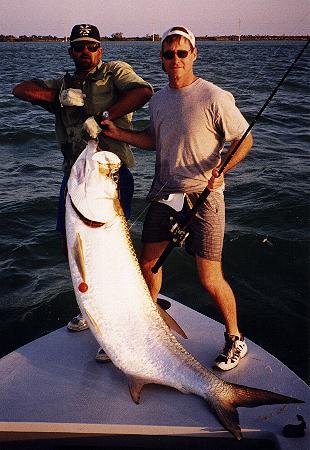
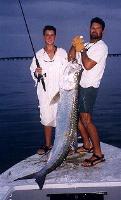



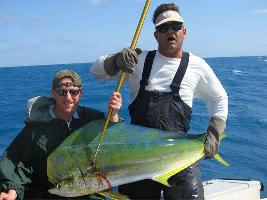

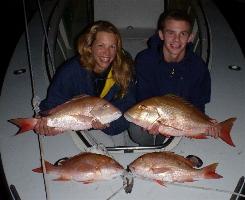


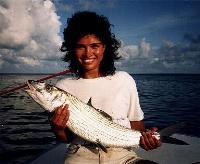
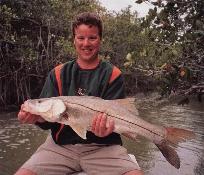
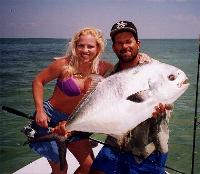

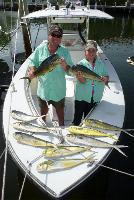
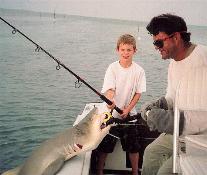





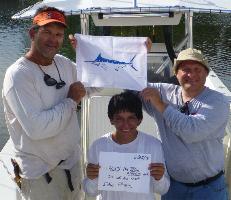
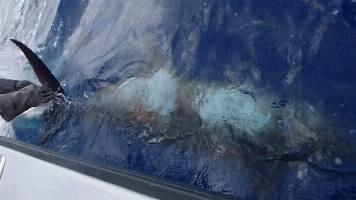
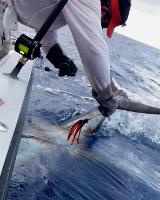
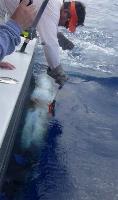

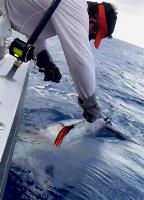
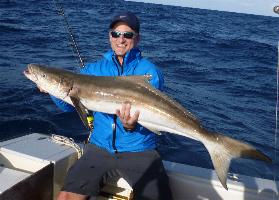

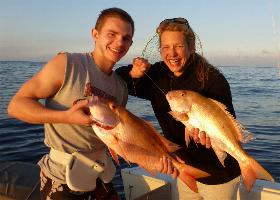
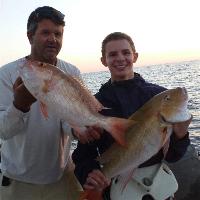
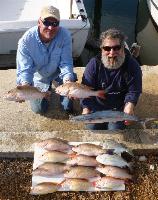
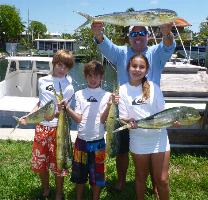
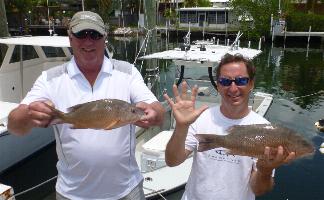
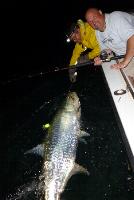
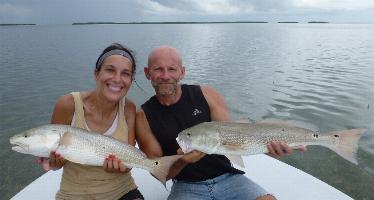









 I decide to run in to hit a
wreck for snapper or amberjacks, because the dolphin fishing was spotty for
keepers. That was a good decision. First drop Chris hooks and catches a nice
mutton snapper around 14 pounds. Then we dropped a second time
for Hope, and she catches another mutton snapper around 12 lbs.
In two drops we catch two big mutton snapper at the end of the day. Now a
day that started out tough for dolphin just became a GREAT DAY: one
sailfish released, two big mutton snappers, and a good box of dolphin.
Photos will be up this week.
I decide to run in to hit a
wreck for snapper or amberjacks, because the dolphin fishing was spotty for
keepers. That was a good decision. First drop Chris hooks and catches a nice
mutton snapper around 14 pounds. Then we dropped a second time
for Hope, and she catches another mutton snapper around 12 lbs.
In two drops we catch two big mutton snapper at the end of the day. Now a
day that started out tough for dolphin just became a GREAT DAY: one
sailfish released, two big mutton snappers, and a good box of dolphin.
Photos will be up this week. 



























 The next day we ran back to
Flamingo and East Cape to fish for black drum, and that paid off even though
the water temperature was very cold. They caught around 20 nice black drum
on #10 spin, a few nice trout, and a redfish. Hey, could we call it the
"Back country, Poor Man's, Rock Bottom, Channel SLAM!" Why not, everyone
else is creating all these other versions of "fishing slams!"
The next day we ran back to
Flamingo and East Cape to fish for black drum, and that paid off even though
the water temperature was very cold. They caught around 20 nice black drum
on #10 spin, a few nice trout, and a redfish. Hey, could we call it the
"Back country, Poor Man's, Rock Bottom, Channel SLAM!" Why not, everyone
else is creating all these other versions of "fishing slams!" 



